A White Star Line híres hajóosztálya, a "Nagy Négyes" első egysége, a CELTIC 1928. december 10-én futott zátonyra Queenstown (ma: Cobh) előtt. Ennek 2023. december 10-én éppen 95 éve. Az évfordulóra emlékezve felidézzük a TITANIC-ot közvetlenül megelőző hajótípus keletkezésének és szolgálati eseményeinek történetét, a CELTIC kronológiája segítségével.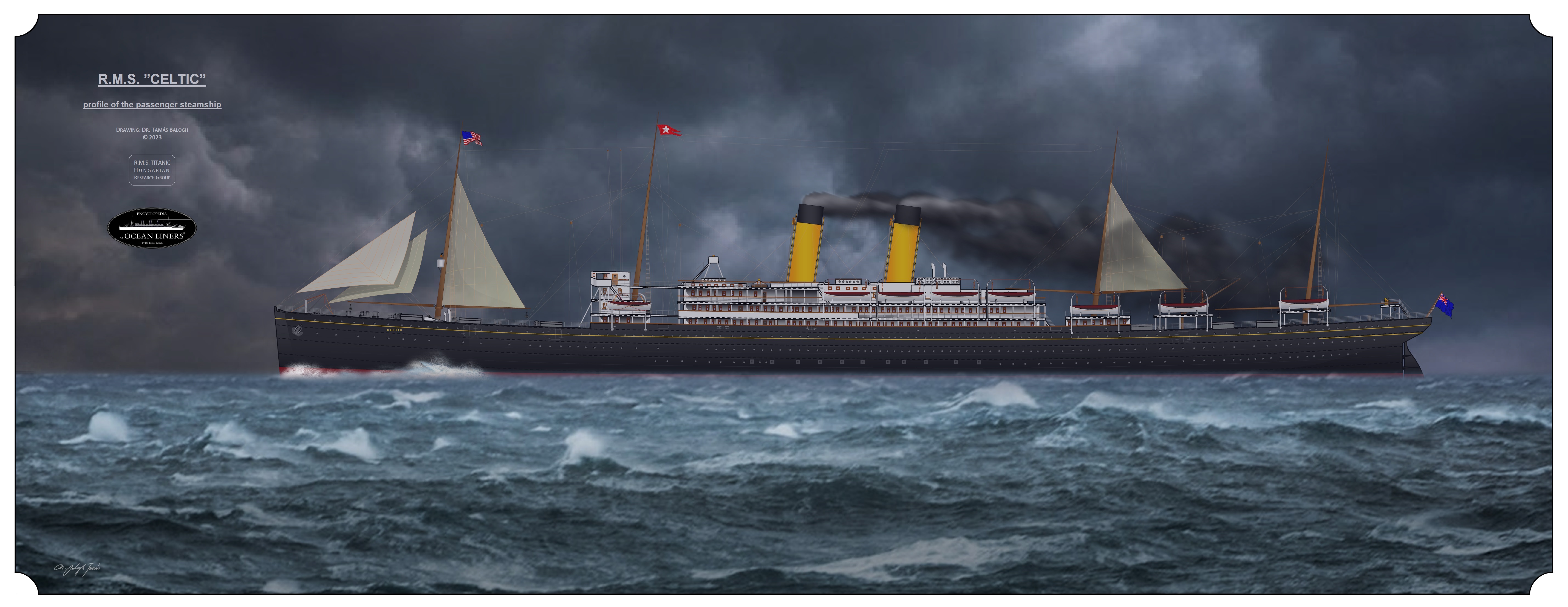
1. ábra: A CELTIC atlanti viharban (rajz: Dr. Balogh Tamás).
1868.01.18.: A brit Thomas Henry Ismay (1837-1899), a National Line hajóstársaság igazgatója, az 1845-ös alapítású angol hajótársaság, a White Star Line – WSL részvényese, 1 000 fontért megvásárolja a csődtől fenyegetett WSL, jelkép- és névhasználati jogait, majd saját vállalatot alapít Oceanic Steam Navigation Company – OSCN (Óceáni Gőzhajózási Társaság) néven. Az OSNC alapítását Gustavus Schwalbe német bankár, liverpooli hajótulajdonos anyagilag támogatja, ha a társaság a hajóit kizárólag a belfasti Harland & Wolff – H&W hajógyárban rendeli meg, ahol Schwalbe unokaöccse, Gustav Wolff, társtulajdonos. Ismay elfogadja az alkut, ha a H&W is kötelezi magát, hogy nem épít hajókat a WSL riválisainak.
1869.07.30.: Az OSNC első megrendelése a H&W-től az új táraság első hajója, a későbbi OCEANIC (I.) felépítésére. Az OSNC üzemeltetése érdekében Ismay társul William Imrie-vel, az Imrie and Tomlinson Társaság tulajdonosával (ez a vállalat William Imrie atyai öröksége, s Ismay-jel együtt mindketten itt gyakornokoskodtak) és William Samuel Graves-szel, s együtt létrehozzák az Ismay-Imrie and Co. vállalatot, amely az OSNC anyavállalataként működik tovább. Az Ismay vezette OSCN feladata lesz a gőzhajók, az Imrie vezette North West Shipping Company – NWSC feladata pedig a vitorlások üzemeltetése.
2. ábra: Birodalomépítők: Thomas Henry Ismay (1837-1899), Gustav Christian Schwalbe (1813-1897), Gustav Wilhelm Wolff (1834-1913) és Sir Edward Harland (1831-1895).
1870.08.27.: Az OCEANIC (I.) nevű gőzhajója vízrebocsátásával a Thomas Henry Ismay vezette WSL hajótársaság megkezdi új utasszállító-flottája kiépítését. Az első egységet a következő két évben azonos tervek alapján gyártott további három egyforma (ATLANTIC, BALTIC, REPUBLIC) és két további, némiképp megnövelt méretű hajó követi (ADRIATIC, CELTIC). Thomas Henry Ismay célja az észak-atlanti hajóforgalom legjobb – legelegánsabb, legkényelmesebb, legbiztonságosabb és leggyorsabb – szolgáltatást nyújtó hajóparkjának kialakítása.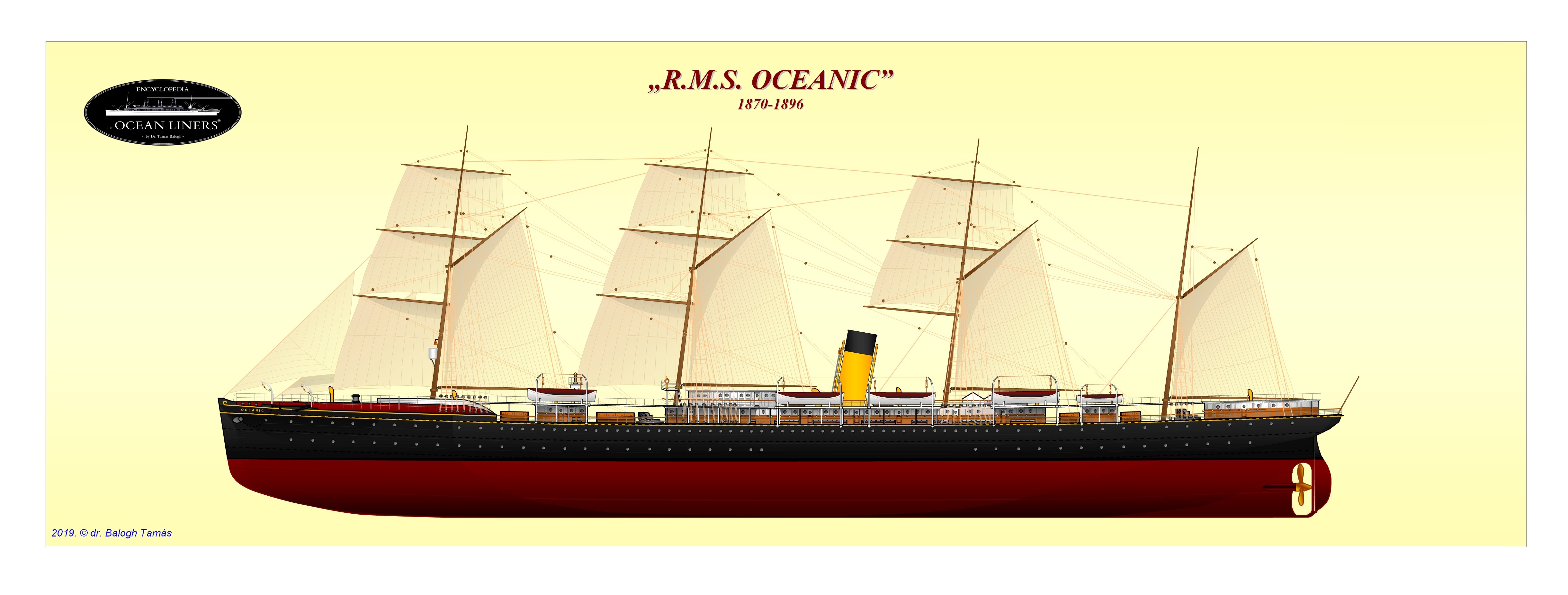
3. ábra: Az OCEANIC és testvérei voltak a legelső óceánjáró személyszállító hajók, amelyek esetében a Sir Edward Harland által 1867-ben kifejlesztett (és addig csak áruszállító hajókon alkalmazott) „dobozos” hajótestformát alkalmazták, elhagyva a hajótestek keresztmetszetének a megelőző évszázadokban kialakult félkör-, vagy ahhoz közelítő szegmensíves alakját, amit nélkülözhetetlennek tartottak a hullámokon hánykolódó és keresztirányban billegő hajó egyensúlyának folyamatos visszanyeréséhez. A White Star-hajók hosszúak voltak és keskenyek, középen teljesen lapos hajófenékkel, amelyet csak egy egészen kis sugarú ív kapcsolt a függőleges oldalfalakhoz. Kritikusaik a dobozos forma miatt csak „koporsóknak” nevezték őket és meg voltak győződve arról, hogy képtelenek kibírni az óceáni átkelést. Harland azonban a fedélzeteket is vasból készítette, belső merevítést adva a bordák alkotta keretnek és az azokból összeállított szekrényes tartónak (a hajótestnek). A lapos hajófenék pedig a kétkedők állításaival szemben nemhogy csökkentette volna, de kifejezetten fokozta a stabilitást, hiszen az addig erősen ívelt hajófenék szögletesítésével nőtt a raktárkapacitás, a hajó víz alatti részeinek terhelhetősége, ami alacsonyan tartotta a súlypontot, minimálisra csökkentve a borulékonyágot. Az új hajók ráadásul nemcsak nagyobb szállítókapacitással rendelkeztek a riválisaiknál, de gyorsabbak is voltak. A „koporsó” nem túl hízelgő jelzője helyébe így hamarosan a „tengeri agár” álmélkodó – csodálkozással és tisztelettel vegyes – kifejezése lépett. Különösen, hogy a víz alatti részek térfogatbővítésével megnövelt stabilitás megengedte nagyobb nyílászárók beépítését a felső fedélzeteken, így a White Star Line hajóin minden belső tér tágas volt és világos. A hajók általános elrendezését az első osztály igényeinek rendelték alá, amennyiben az első osztályú szállásokat és közösségi helyiségeket a hajó közepén, a vibráló és zajos gépektől a legtávolabb, egyben a legkiegyensúlyozottabb helyen alakították ki, míg a harmadosztály szállásait a hajóorrban és a hajótatban helyezték el: elöl az egyedülálló férfiak, hátul az egyedülálló nők és a családok szállásaival. Az első osztályon először alakíthattak ki akkora étkezőt, melyben nem volt szükség turnusos étkeztetésre: az utasok egyszerre foglalhattak helyet a maguk asztalánál, s elektromos csengővel szólíthatták az utaskísérőket a lakosztályaikba, melyek kényelme és lenyűgöző megjelenése alapján a kor sajtója szerint az OCEANIC „inkább birodalmi jacht, mint utasszállító”, amely „a White Star Line-t avatta a kényelem döntőbírájává az Északatlanti-óceánon”. (rajz: Dr. Balogh Tamás)
1873.04.01.: Az OCEANIC testvérhajója, az ATLANTIC viharos időben Halifax felé tart, ám anélkül, hogy a személyzete érzékelné, letér a meghatározott útvonalról, s partközelben víz alatti sziklának ütközik, felborul és elsüllyed, a fedélzetén tartózkodó 952 ember közül 585 meghal, köztük minden nő és egy kivételével az összes gyermek (a TITANIC 1912-es elsüllyedésééig ez a WSL legnagyobb katasztrófája).
1874.02.03.: A BRITANNIC (I.), majd a néhány hónappal később épült testvérhajója, a GERMANIC – a WSL első kétkéményes óceánjárói – tovább fokozzák az OCEANIC és testvérei bevezette kiválóságot. 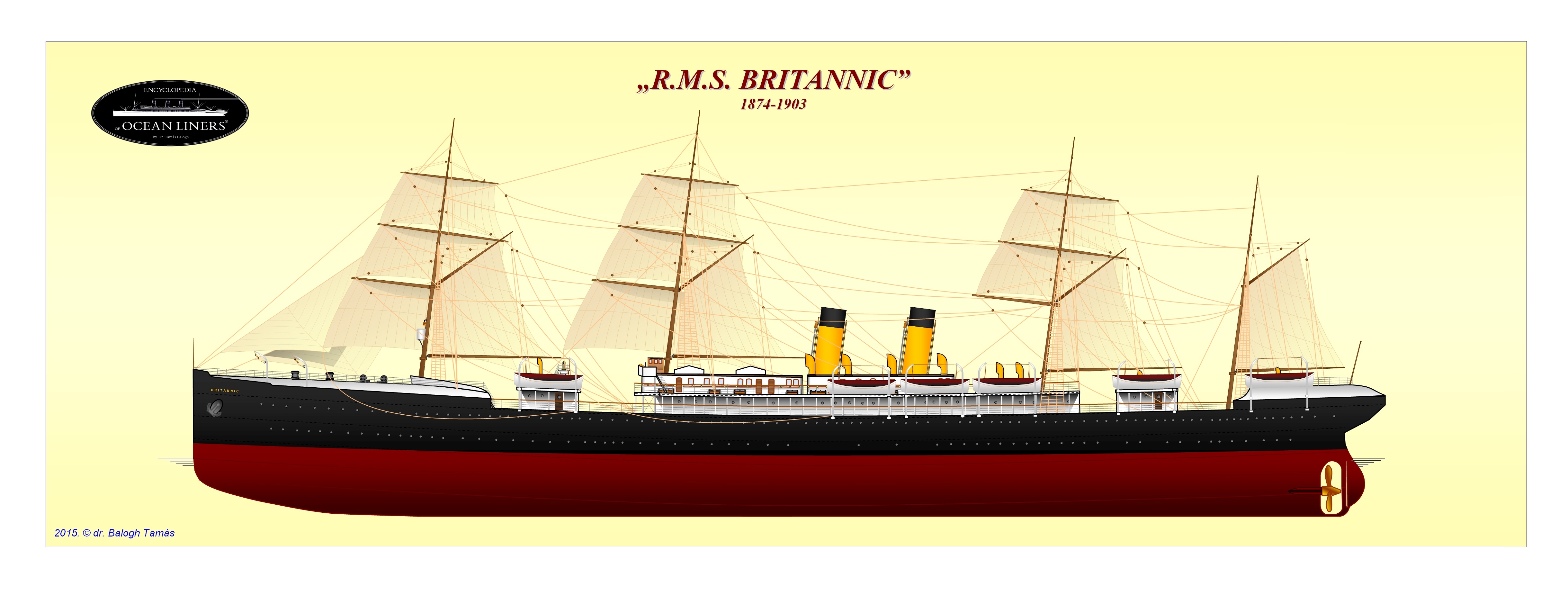
4. ábra: A hajókon már nemcsak a jól ismert hajótest-forma, a megnövelt stabilitás, a tágas és világos belső terek, s a pazar berendezés fokozta azt utasok kényelmét, de a gőzüzemű légcserélővel működtetett szellőzőrendszer is, amely a hajó minden részébe igény szerint meleg, vagy hideg levegőt juttatott. Bár a kor hajóihoz hasonlóan még a White Star Line hajóit is csak egyetlen hajócsavar hajtotta (ezért a meghibásodás miatti irányíthatatlanná válás elkerülése érdekében négyárbocnyi segédvitorlázattal is felszerelték őket), a hajók rekordsebességgel keltek át az Atlanti-óceánon (a nyugati irányú átkelés sebességi rekordját a BRITANNIC 1877-ig, a GERMANIC 1882-ig őrizte, a keleti irányúét pedig mindketten 1876-ig tartották). A BRITANNIC 1899-ig szolgált, akkor a brit kormány vette igénybe hadiszállítási célokra a búr háborúkban, majd 1903-ban lebontották, a GERMANIC pedig 1910-ig maradt a WSL kötelékében, amikor Törökországba értékesítették, ahol 1950-ig teljesített szolgálatot. (rajz: Dr. Balogh Tamás)
1889.01.19.: A fokozatosan egye jobban elavuló OCEANIC-osztály felváltására – elsőként az osztályból kiesett két óceánjáró, az ATLANTIC és a BALTIC pótlására – megrendelt új óceánjáró-típus, a TEUTONIC-osztály első, névadó egységének vízrebocsátása.
Mivel Thomas Henry Ismay úgy igyekezett kormányzati támogatást szerezni az óceánjáró felépítéséhez, hogy felajánlotta az Admiralitásnak: állami támogatás esetén a haditengerészet igényeinek megfelelően épül majd a hajó (ez a felajánlás és annak elfogadása vezet a WSL és a brit kormány közötti ún.: British Auxiliary Armed Cruiser Agreement [a brit segédcirkáló-megállapodás] aláírásához), a TEUTONIC ágyúkkal felszerelve vesz részt a flottaparádén, és mély benyomást tesz II. Vilmosra, aki a látogatás végén kijelenti: "feltétlenül szükségünk van néhányra ezek közül" a hajók közül. A TEUTONIC ezzel a német óceánjáró-építési program ösztönzőjévé válik.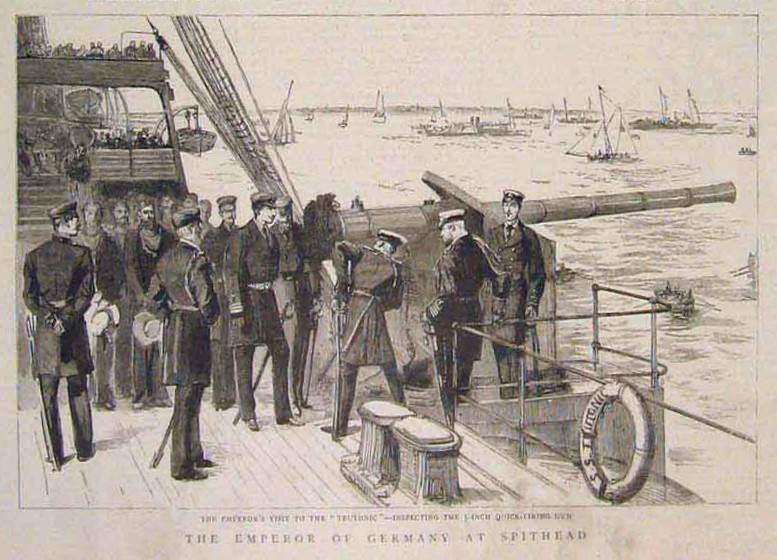
5. ábra: „A német császár a 6 hüvelykes gyorstüzelő ágyút szemléli a TEUTONIC fedélzetén.” – illusztráció a The Graphic c. brit képes újság 1889. augusztus 10-i, vasárnapi számában.
A brit segédcirkáló-program elindítását az orosz cári haditengerészet egységeinek kiegészítésére Nagy-Britanniában rendelt óceánjárók felfegyverzésének gyakorlata (az Orosz Önkéntes Hajóraj 1878-as felállítása) siettette, mivel Nagy-Britannia úgy érezte, hogy ilyen körülmények között neki is szüksége van rá, hogy hasonló hajók szolgálatba állításával védje meg tengeri kereskedelmét az orosz hajóraj egységeitől. Ennek a következménye, hogy Thomas Henry Ismay felajánlását a brit kormány kedvezően fogadta és 1889-től kezdve a civil hajótársaságokkal kötött postaszállítási szerződéseket segédcirkáló-építési és üzemeltetési megállapodás rendelkezéseivel egészítette ki.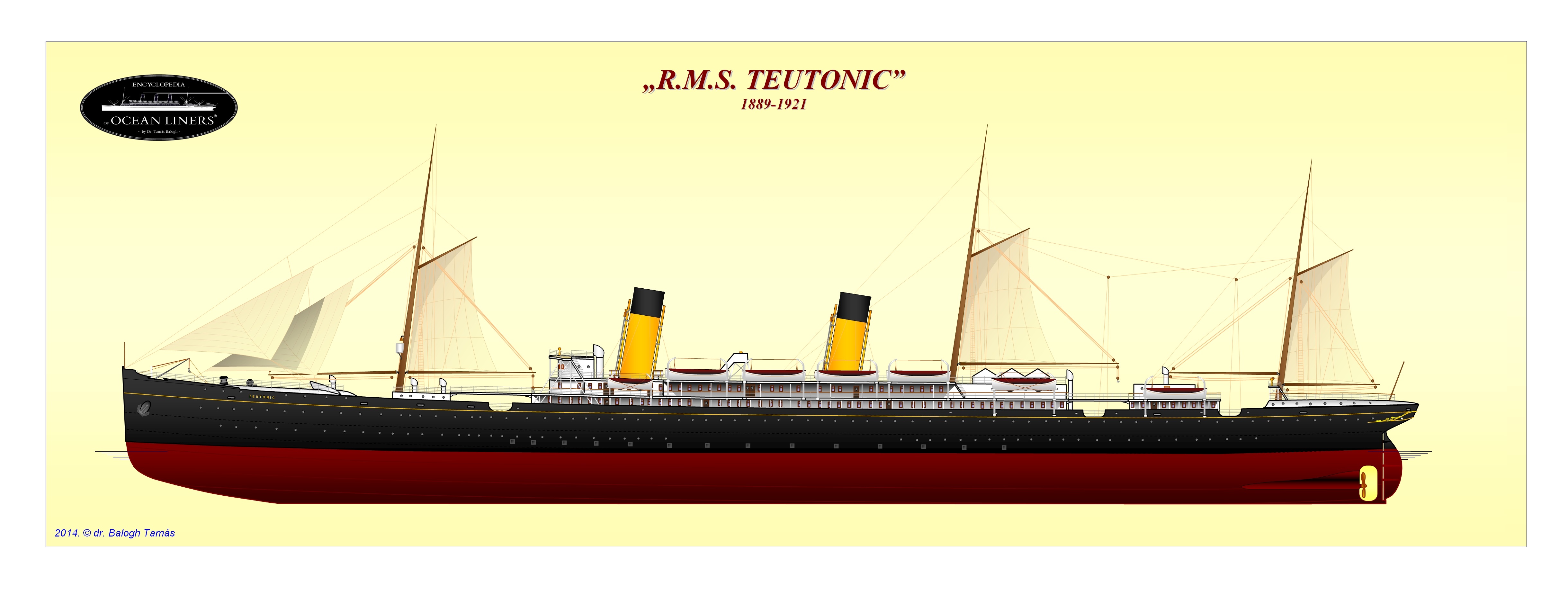
6. ábra: Míg az OCEANIC-osztály hajóinak a térfogata még csak 3 807, a BRITANNIC-osztály hajóié pedig 5 004 tonnát tett ki, addig a TEUTONIC és testvére, a MAJESTIC (I.) térfogata már 9 984 tonnára rúgott. A méretek növelésével párhuzamosan a géperőt (a kazánok számát, a gépek nagyságát és a széntárolók méretét) is növelni kellett. A hajó terveit arra tekintettel készítették el, hogy sebességi rekordot döntve visszaszerezze a leggyorsabb atlanti átkelésért járó „Kék Szalag” díjat a WSL számára, egyúttal arra is alkalmassá tették, hogy háború esetén felfegyverezve a flotta segédcirkálójaként tevékenykedhessen. Amikor terveit bemutatták az Admiralitásnak, az lelkesen „a valaha készült legjobb hajótervnek” minősítette azokat. A hajók tervezője, Alexander Carlisle, a H&W mérnöke még sokszor bizonyítja majd rátermettségét a későbbiekben. (rajz: Dr. Balogh Tamás)
1895.05.17.: Az OCEANIC selejtezése. A WSL északatlanti flottája ismét kiegészítésre szorul. Megkezdődnek az előkészületek egy újabb nagy hajóosztály felépítésére. A fejlesztést több szempont befolyásolja.
Egyrészt az 1890-es évek végére WSL nagy presztízsű TEUTONIC-osztályú óceánjárói számára a versenytársak erős kihívást támasztottak: a brit Cunard Line 1893-ban bemutatta a CAMPANIA és a LUCANIA testvérhajókat, a német Norddeutscher Lloyd pedig a II. Vilmos Spithead-i flottaparádén tett látogatásának tapasztalatai alapján építendő négy új KAISER-osztályú óceánjárója közül az első, a KAISER WILHELM DER GROßE terveit. Ahhoz, hogy felvehesse a versenyt ezekkel a hajókkal, a WSL-nek új zászlóshajóra volt szüksége.
Másrészt a hajósgazdák elsősorban a befektetésük megtérülését kívánták akkor, amikor megrendelést adtak egy-egy új hajó felépítésére. A sebességi rekordok oltárán ekkoriban viszont már pont a jövedelmezőséget kellett feláldozni: egy-egy csomónyi sebességnövelés már akkora mennyiségű többlet üzemanyagot, gépészetet és (fűtő-)személyzetet igényelt, aminek a költségvetését nem lehetett többé megalapozni a hajókra szóló jegyeladásokból, illetve a velük történő posta- és áruszállítási díjakból. Főleg, hogy a széntárolók és a gépészet helyigényének növelése a kereskedelmi szempontból fontos utas- és rakterektől vette el a helyet.
Az utasok többsége számára ráadásul egyre kisebb vonzerővel bírt az, hogy néhány órával hamarabb érkezzenek meg az úti céljukhoz, mint a rivális társaság hajói, főleg, ha a teljes erővel zakatoló gépek erőteljes vibrációja megkeseríti számukra az utazást. A világ közvéleménye pedig ekkorra már hozzászokott ahhoz, hogy a hajózási rekordok sem tartanak örökké: a legnagyobb és a leggyorsabb hajóknak járó elismerés legfeljebb néhány hónapig tarthat, mert kis túlzással szinte minden új hajó, amely felépül a legnagyobb vagy a leggyorsabb lesz az átadása pillanatában.
A józan számítás eredménye így a méret és a kényelem előnyben részesítése lett a sebességgel szemben, ami olyan új hajóterveket eredményezett, amelyek – bár nem a legnagyobbak a világon – nagyobbak, mint a TEUTONIC és a MAJESTIC, vagy a CAMPANIA és LUCANIA, de nem gyorsabbak azoknál.
1897.01.09.: Az új tervek alapján épült első WSL-gőzös, a CYMRIC gerincfektetése.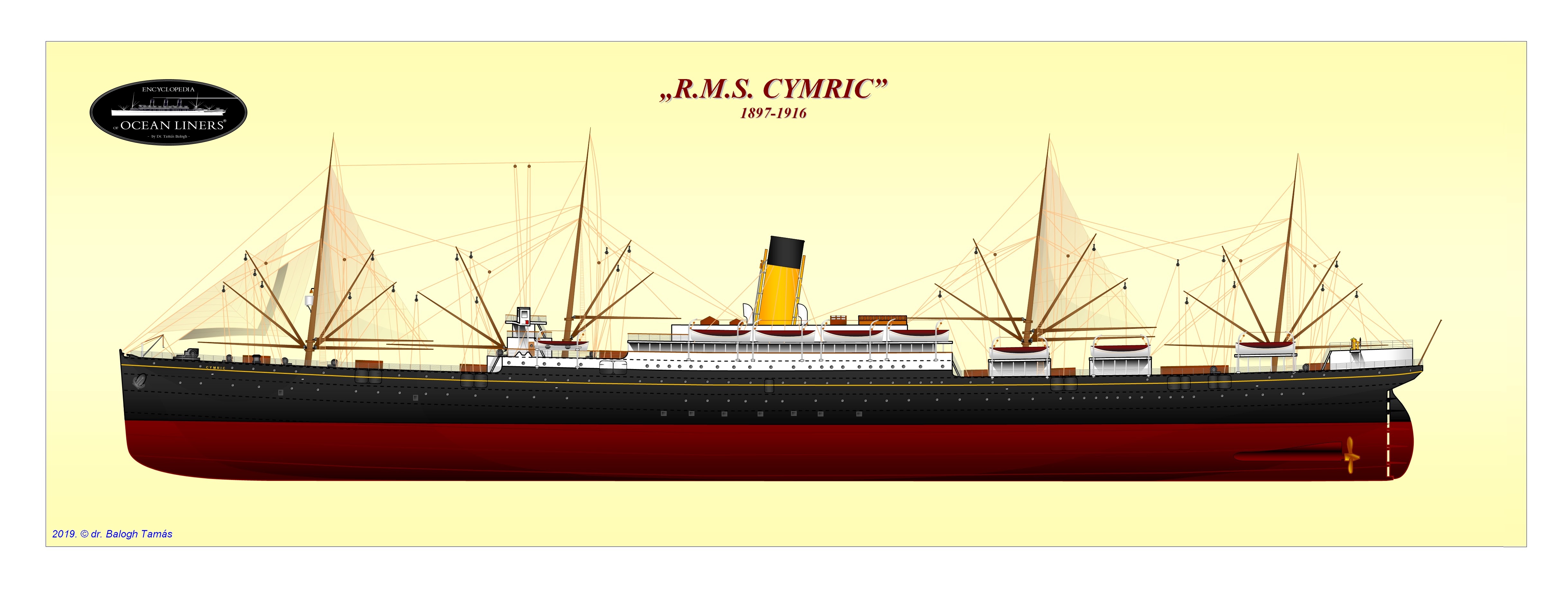
7. ábra: A hajót eredetileg kombinált utas- és áruszállító hajónak tervezték, amelyen csak első osztályú utasokat fogadtak volna, az összes többi teret pedig élőállatok (szarvasmarha) szállítására tartották fenn. Az utasok és az állatállomány közös szállításának gondolata azonban már a tervezés időszakában túlságosan népszerűtlennek bizonyult, ezért a teherterek helyére harmadosztályú szállásokat terveztek anélkül, hogy a viszonylag kis teljesítményű gépészeten módosítottak volna. Így a korábbi rakterek és a viszonylag kis géptér által biztosított nagy belső térfogat segítségével olyan hajót hoztak létre, amely viszonylag lassú volt a sebesség-orientált utasszállítókhoz képest, de sokkal nagyobb belső térrel és ennek köszönhetően szokatlanul magas fokú kényelemmel rendelkezett. A kisebb teljesítményű gépek ráadásul kevesebb zajt és vibrációt keltettek, ami egyrészt megnyugtatta az utasokat, másrészt sokkal alacsonyabb üzemeltetési költségeket eredményezett. (rajz: Dr. Balogh Tamás)
A CYMRIC bevezeti a „sebesség helyett luxust” stratégiáját. A White Star Line ezt a stratégiát követi akkor, amikor újabb megrendelést ad a Harland & Wolff Hajógyárnak új hajók tervezésére azután, hogy a hajótársaság legelső hat hajója közül (az OCEANIC-osztályból) egy kivételével az összes egység elhagyta a szolgálatot. A tervezés kezdettől fogva két irányt követ:
Egyrészt eldöntik, hogy az új stratégiát adaptálják majd a TEUTONIC-osztály terveinek továbbfejlesztésével tervezett új hajóosztályra is, amelyben (az alaptípushoz hasonlóan) további két hajót építenek, amelyek az OCEANIC (II) és az OLYMPIC nevet viselik majd, s csak 21 csomós (39 Km/h) sebességre lesznek képesek (ami menetrend-tervezési szempontból előnyös, mert így lépést tarthatnak az ugyanekkora sebességre képes TEURONIC-kal és MAJESTIC-kel, s arra is alkalmassá válnak, hogy teljesítsék a segédcirkáló-megállapodás feltételeit), de ennél jobban nem fokozzák a sebességüket, mivel nem várnak sebességi rekordot tőlük.
Másrészt – kifejezetten a CYMRIC terveinek továbbfejlesztésével – négy másik hajót is felépítenek majd a meglehetősen átlagos, 16 csomós (30 Km/h) menetsebességre optimalizálva, de egyedülállóan nagy méretekkel, nagy teherterekkel és pazarul berendezett, tágas utasterekkel (anélkül, hogy felfegyvereznék, s háború esetén segédcirkáló-feladatok ellátására ajánlanák fel ezeket a Kormány számára). Ezt a típust egyelőre csak úgy nevezik: a „Nagy Négyes”.
Ezzel a tervek szerint tehát végül is négy gyorsgőzös (TEUTONIC, MAJESTIC, OCEANIC (II), OLYMPIC) és négy mérsékeltebb sebességű, de extrémnagy befogadóképességű vegyes rendeltetésű (személy- és áruszállító) gőzhajó alkotná a WSL északatlanti flottáját.
Az első négyes hajói tartoznának az állammal kötött postaszállítási- és segédcirkáló-megállapodás hatálya alá egyaránt, míg a második négyesre kizárólag a postaszállítási megállapodás hatálya terjedne ki (vagyis a brit állam az első négy hajó esetében az építkezéshez is anyagi támogatást nyújtana, míg a második négyes esetén csak az üzemeltetéshez).
A tervezők számára átadott megrendelői specifikációt Thomas Henry Ismay határozza meg, mindkét típus tekintetében a „sebesség helyett luxust” stratégia alapján: „A legkiválóbbat, semmi mást!” Mindez az OCEANIC (II) osztály esetében a világ leghosszabb, a „Nagy Négyes” esetében pedig a világ legnagyobb (térfogatú) hajóinak a felépítését jelenti. Számítása szerint ezzel továbbra is a britek tudhatják magukénak az elsőséget a hajógyártás összes jellemző teljesítménye tekintetében, hiszen a világ leggyorsabb, leghosszabb és legnagyobb hajóit egyaránt brit gyárak építenék és brit társaságok üzemeltetnék. A WSL pedig úgy részesül a dicsőségben, hogy a jövőben nem kell részt kellene vennie a nagy sebességű óceánjárók felépítésének és üzemben tartásának meglehetősen költséges sportjában (minthogy a pénzügyileg fenntartható működés érdekében lemond erről a dicsőségről a rivális brit hajótársaság, a Cunard Line javára).
1897.03.18.: Az OCEANIC (II) gerincfektetése Belfastban, a H&W telephelyén.
1897.05.04.: A német KAISER WILHELM der GROßE óceánjáró vízrebocsátása.
1898.04.03.: A KAISER WILHELM der GROßE 22,29 csomós (41,3 Km/h) sebességgel elhódítja a Kék Szalagot a Cunard Line LUCANIA nevű óceánjárójától. Első ízben fordul elő, hogy a világ legnagyobb és leggyorsabb hajója nem brit, hanem német. A leggyorsabb atlanti átkelésért járó elismerést ettől kezdve 1907 októberéig megszakítás nélkül kizárólag különböző német óceánjárók birtokolják. Megkezdődik az óceáni személyhajózás „német évtizede”. A sértett brit nemzeti büszkeség elégtételt keres, így a tervezett WSL-hajók – az építés alatt álló OCEANIC(II)-osztály, s a közvetlenül utána építendő Nagy Négyes – egy csapásra az érdeklődés középpontjába kerül, hiszen nekik kell visszaszerezni a németektől legalább a világ leghosszabb és a legnagyobb (térfogatú) hajóinak kitüntető címét Nagy-Britannia számára.
1898.09.10-12.: A Nagy Négyes első egységének megrendelését megerősítő szerződéskötéshez kapcsolódó levélváltás a White Star Line hajótársaság és a Harland & Wolff Hajógyár között.
1899.01.14.: Az OCEANIC (II) vízrebocsátása Belfastban. A 215 m hosszú új WSL-gőzös az első óceánjáró, amelynek sikerült felülmúlnia a 40 évvel korábban épült híres GREAT EASTERN óriásgőzös 211 m-es hosszát.
8. ábra: A 17 274 tonnás OCEANIC (II) rekordot nem jelentő 21 csomós sebességének fenntartása önmagában 15 kazánt igényelt. Ehhez képest a 12 552 tonnás CYMRIC-nek csupán 7 kazánra és sokkal kevesebb szénre volt szüksége a maga 15 csomós (27,8 Km/h) sebességének fenntartásához, miközben a gépészeti terek kiterjedésének korlátozottsága folytán sokkal nagyobb utas- és raktér állt rendelkezésre a fedélzetén (8 123 tonna a 6 996 tonnához képest). Vagyis az OCEANIC (II) hiába volt nagyobb hajó, a CYMRIC-et kisebb méretei ellenére is jobban használhatták az utasok és az áruk jövedelmező szállítására. A The Graphic magazin 1900. január 21-i száma (a következő oldalon) mindazonáltal lelkes beszámolót közölt a vízrebocsátásról: „Szombaton a Harland & Wolff belfasti telepén, a Queen’s Island-en vízrebocsátották a White Star Line részére épített OCEANIC nevű új duplacsavargőzöst. A mérnöki tudományok ünnepét jelentő esemény új korszak kezdetét jelzi a hajóépítés történetében, minthogy az OCEANIC a valaha épült legnagyobb hajó.” Építéséhez a H&W telephelyén új portáldarura volt szükség, s elsőként alkalmazták a hidraulikus szegecselést. (rajz: Dr. Balogh Tamás)
1899.02.12.: Az OCEANIC (I) testvérhajója, az ADRIATIC selejtezése (és bontása Thomas W. Ward hajóbontójában, Prestonban). Ezzel teljessé válik a WSL első hajóosztályának a szolgálatból történt kivonása (az ATLANTIC még 1873-ban elsüllyedt, a BALTIC-ot és a REPUBLIC-ot 1888/1889-ben eladták Hollandiába, a CELTIC-et 1893-ban Dániába, az OCEANIC-et pedig 1895-ben lebontották).
1899.01.14.: Az OCEANIC vízrebocsátása után Thomas Henry Ismay mellkasi fájdalmakra panaszkodik. Mivel egész életében csak ritkán volt beteg, az orvosa nagyon komolyan veszi a panaszait, ennek ellenére Ismay állapota lassan ugyan, de egyre jobban romlik. Az OCEANIC testvérhajójának megrendelése csúszik.
1899.03.22.: A Nagy Négyes első egységének gerincfektetése 335-ös gyártmányszámmal. Thomas Henry Ismay egészségi állapota javulni kezd. Feleségével Windermere-be utazik, ahol újabb rosszullét tör rá. Felesége orvost hívat, aki morfiumot rendel. Ismay hat nap múlva jobban érzi magát, s visszatérnek Dawpoolba.
1899.04.26.: Hat héten keresztül tartó heves fájdalmak után – melyeket az orvos epekőként diagnosztizál – Ismay újra elég jól érzi magát a munkához.
1899.08.30.: Ismay összeesik és ágyba kényszerül. Másnap megműtik, de a műtét sikertelen.
1899.09.01.: Elkészül a 335-ös gyártmányszámú hajótest fenékbordázata a kettős fenék magasságáig.
1899.09.04.: Ismay második műtétje.
1899.09.05.: Ismay ragaszkodik hozzá, hogy a lányai vegyenek részt az OCEANIC másnap kezdődő avató útján, feleségét pedig arra kéri, hogy gondoskodjon róla, hogy a helyi egyházi gyülekezet imádkozzon érte.
1899.09.14.: Ismay szívrohamot kap.
1899.11.23.: Ismay 62 éves korában meghal. A White Star Line elnöki tisztségében legidősebb fia, Joseph Bruce Ismay (1862-1937) követi, aki a vállalat képviseletében végzett 10 évig tartó New York-i ügynökösködés után 1891-ben tért vissza az Egyesült Királyságba. Az OLYMPIC megrendelését törlik. J. Bruce Ismay teljes figyelmét az édesapja által megrendelt utolsó hajóosztály, a Nagy Négyes felépítésének végig vitelére fordítja.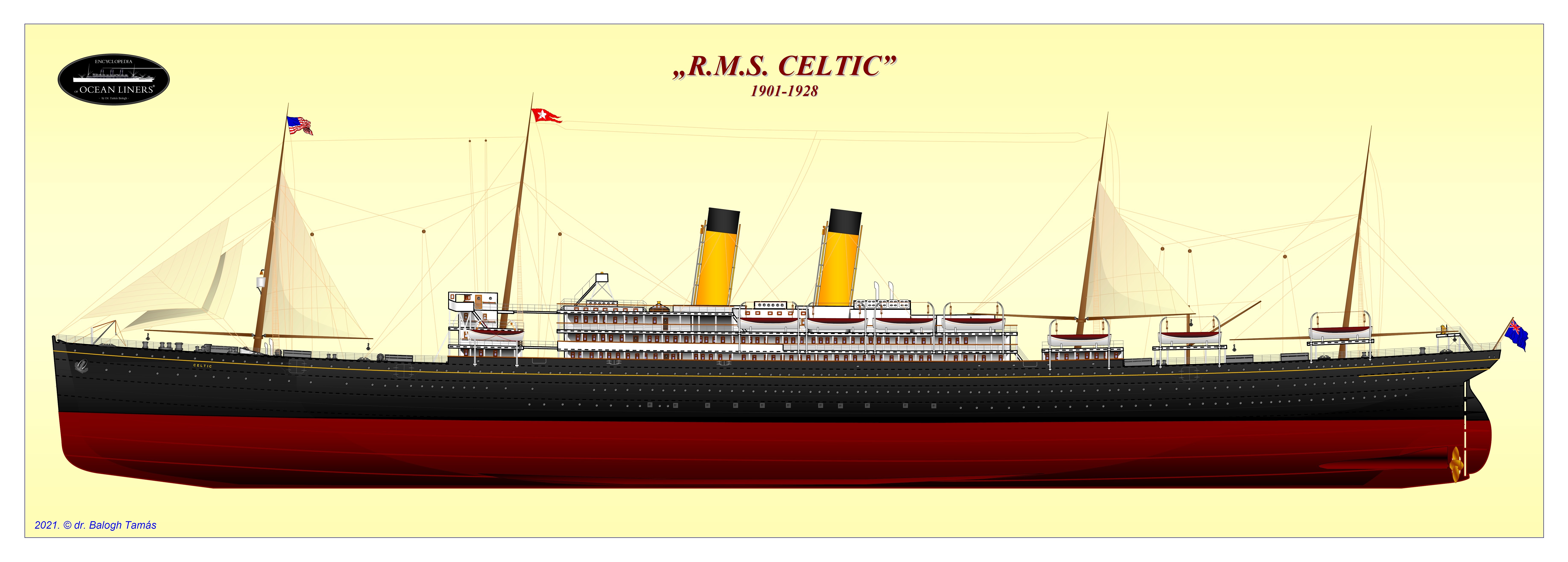
9. ábra: A 335-ös gyártmányszámú hajó hossza megegyezik a GREAT EASTERN hosszával (680 láb, azaz 211 m), amelyhez 75 lábnyi (22,86 m) szélesség társul, így a térfogata jócskán felülmúlja az addigi legnagyobb hajóét (20 904 BRT a 18 915 BRT-hez képest). Ezzel az OCEANIC (II) után – amely túlszárnyalta a hosszát – a GREAT EASTERN térfogatát is sikerül meghaladni, de a hajótest hossz-szélesség aránya az OCEANIC (II)-vel összehasonlítva is nagyobb, 9:1 a 10:1-hez képest. A Nagy Négyes térfogata így 21 %-kal nagyobb az OCEANIC (II) térfogatánál, s a belső terei sokkal jobban kihasználhatók, minthogy az OCEANIC (II) 15 kazánjához képest csupán feleannyi (8) kazánnal épül. A hajótest nagy méretei az építés során különös körültekintést igényelnek az óceáni hullámzás által keltett csavaró-nyíró igénybevételeknek való ellenállás biztosítása (a két hullámhegyen támaszkodó, középen hullámvölgy felett lebegő, illetve a középen hullámhegyen támaszkodó, a két végén hullámvölgy fölött lebegő hajótest kettétörésének elkerülése) érdekében. Ehhez a hajótest felső fedélzetének oldalsó lemezsorát, s a hajófenék középső szakaszának lemezelését megkettőzik, a bordakeretek pedig oszlopos merevítést kapnak. Míg az OCEANIC (II) esetében az általános elrendezést a TEUTONIC-osztály terveinek alapul vételével alakították ki, s a parancsnoki híd egybeépült a felépítménnyel (elegáns, folytonos megjelenést adva a hajónak), a Nagy Négyes esetében a CYMRIC terveihez igazodva osztott – a korabeli terminológia szerint ún.: „szigetes” – felépítményt alakítanak ki, amelyen a tiszti lakrészeket és a parancsnoki hidat befogadó felépítményrészt elválasztják az utasok rendelkezésére álló többi felépítménytől. (rajz: Dr. Balogh Tamás)
1900.01.24.: Elkészül a 335-ös gyártmányszámú egység teljes bordaváza.
1900.10.13.: A Nagy Négyes második egysége, a 337-es gyártmányszámú egység gerincfektetése.
1901.04.04.: A 335-ös gyártmányszámú egység vízrebocsátása CELTIC néven.
1901.07.11.: A hajó hivatalos átadása a WSL részére.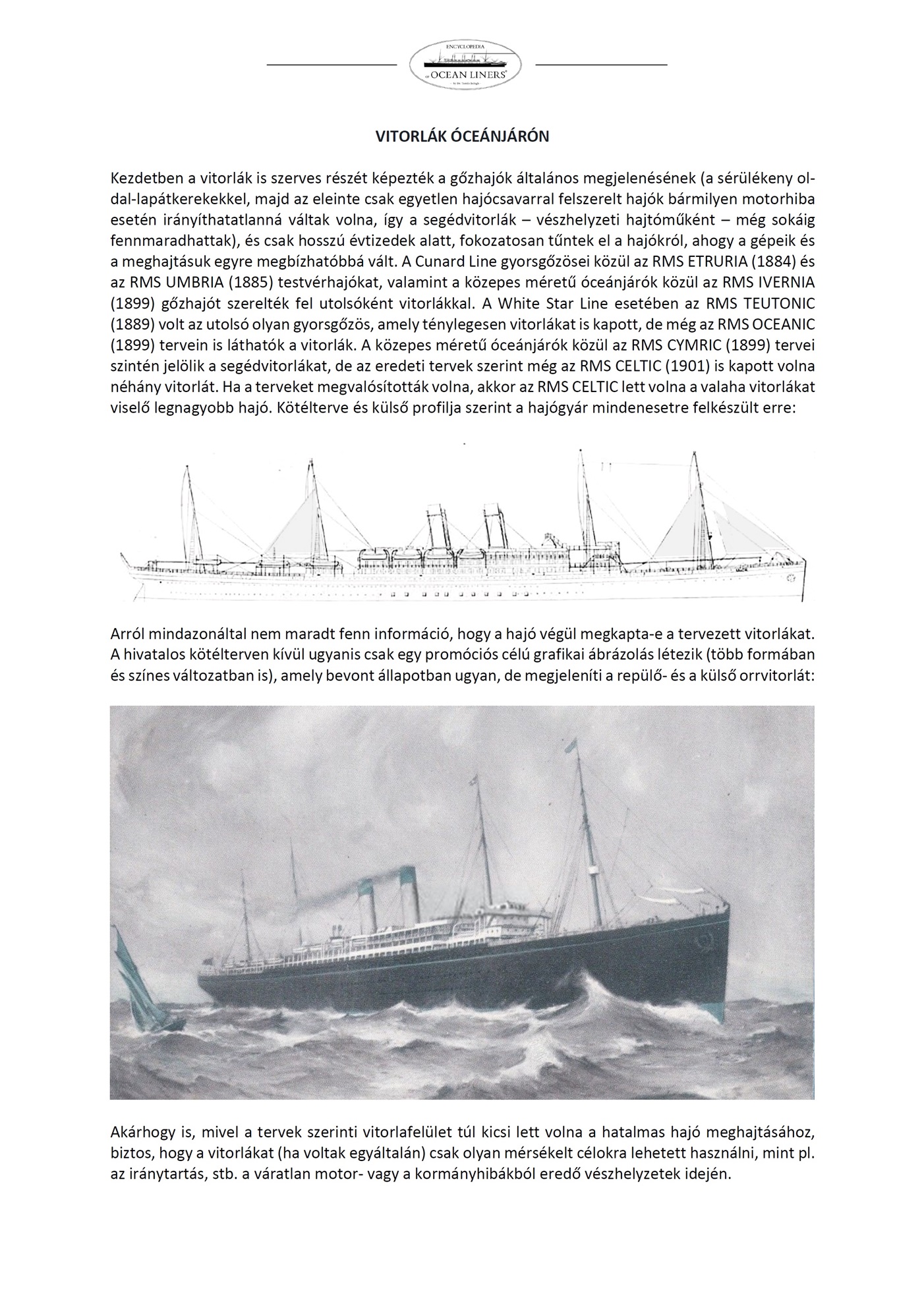
10. ábra: Információ arról, hogy a CELTIC valóban rendelkezett-e vitorlákkal.
1901.07.26.: A CELTIC első útjára indul New Yorkba.
1901.08.04.: Reggel 07:00 órakor a hajó megérkezik New Yorkba. Az út alatt mért átlagos sebessége 17 csomó (31,5 Km/h), egy egész csomóval az építési specifikációban előírt maximális sebesség felett.
A hajó két kazánházában elhelyezett 8 db kétvégű kazán fűtéséhez a teljes út alatt csupán 2 400 tonna szén szükséges a 16 csomó feletti sebesség tartásához, miközben az OCEANIC II esetében a 21 csomós átkeléshez 6 000 tonna kell (a CELTIC napi szénfogyasztása 235 tonna, az OCEANIC-é 450). A hajó három osztályán összesen 2 859 főt (347 első-, 160 másod- és 2 352 harmadosztályú utast) lehet elhelyezni a 335 fős személyzet (a 64 fő fedélzeti matróz és tiszt, a 92 fűtő és gépész, s a 179 utaskísérő) mellett.
Mivel a legtöbb utas harmadosztályon utazhat, különleges figyelmet fordítanak a harmadosztály elhelyezésére: Az összes harmadosztályú utas csaknem kétharmada számára külön kabinokat alakítanak ki, szakítva a nagy közös hálótermekben történő elhelyezés addigi gyakorlatával (noha a legszegényebb egyedülálló férfiutasok számára 2 db, egyenként 300 fő befogadóképességű nagy hálótermet azért fenntartanak). A szalon-fedélzetnek nevezett felső fedélzeten álló felépítmény hátsó részében harmadosztályú dohányzó és nappali áll, egy fedélzettel lejjebb pedig egy-egy nagy étkező a hajótest jobb és baloldalán. A felépítményi helyiségekben ugyanolyan ülőbútorok vannak, mint az étkezőkben, így a harmadosztály teljes foglaltsága esetén azok is étkezővé alakíthatók. A harmadosztályú helyiségeket a többi osztályhoz hasonlóan szintén felszerelik elektromos ventilátorokkal.
Noha a hajótest 36 láb 6 hüvelyk (11,25 m) maximális merülésig terhelhető, csak 31 láb (9,44 m) merülésig engedik megtölteni mindaddig, amíg a New York-i kikötő hajózóútjait ki nem kotorják a hajó maximális merülésének megfelelő mélységben.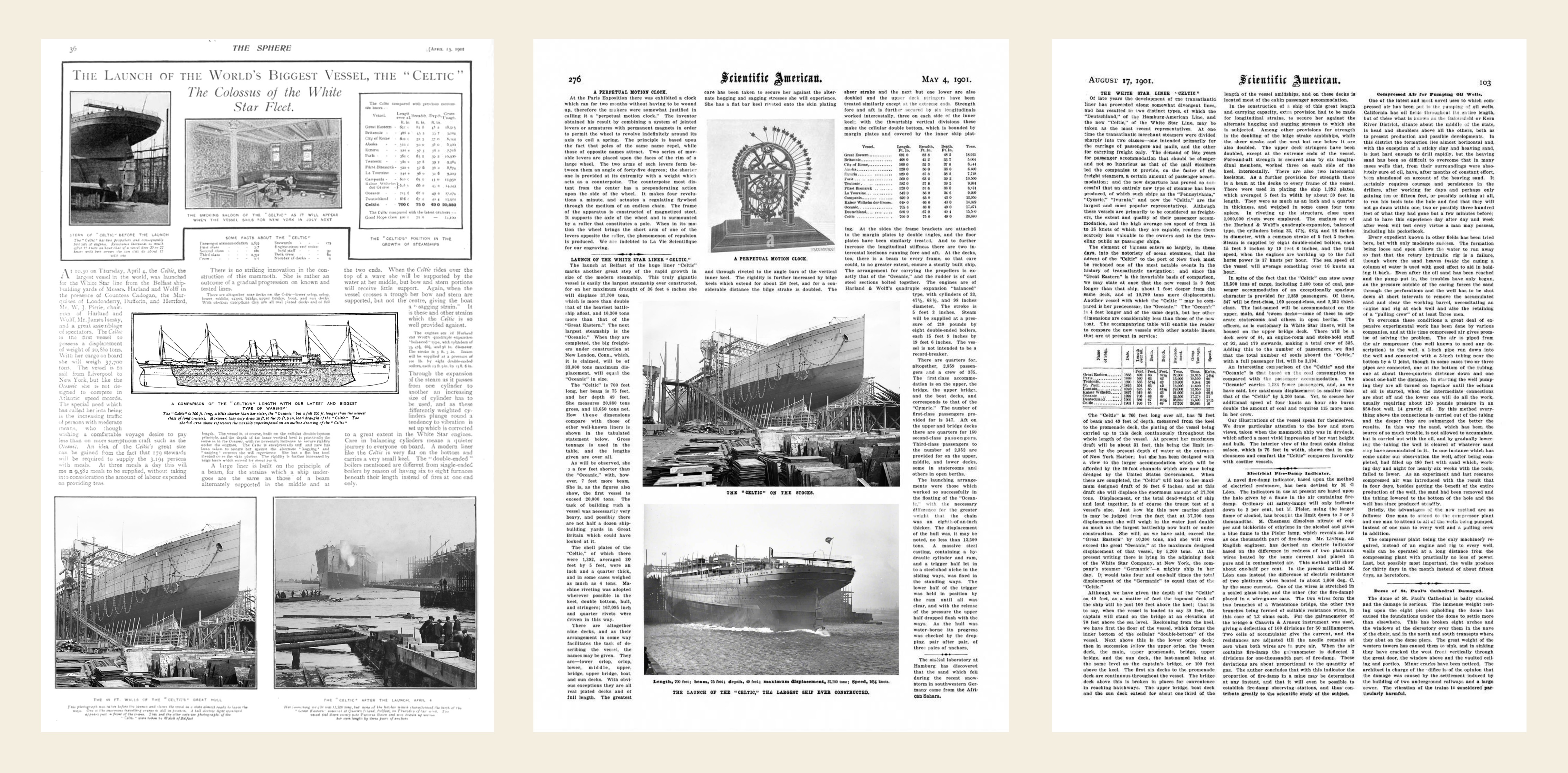
11. ábra: A korabeli sajtónak a CELTIC születéséről tudósító lapszámai Európában (balra) és Amerikában (középen és jobbra) a hajó vízrebocsátásához és első amerikai érkezéséhez időzítve a hajó páratlan méreteinek és berendezésének, illetve költséghatékonyságának részletes ismertetésére. Jellemző részlet a Scientific American c. tudományos ismeretterjesztő folyóirat 1901. augusztus 17-i számából: "A CELTIC 18.500 tonna áru (ebből 2.400 tonna szén) és 2.859 utas szállítására képes, kivételesen tágas karakterének köszönhetően. [...] Érdekes összehasonlítani az OCEANIC-kel a szénfogyasztás és az utasbefogadó-képesség alapján. Az OCEANIC 1.284 fővel kevesebb utast vehet a fedélzetére, a maximális vízkiszorítása pedig 5.200 tonnával kisebb, mint a CELTIC-é. Ahhoz pedig, hogy a csekély 4 csomóval magasabb óránkénti sebességét tartani tudja, kétszer annyi szenet kell elégetnie és 115 fővel nagyobb legénységre van szüksége." A kép a jobb alsó sarokban elhelyezett kettős nyíl ikonra kattintva nagyítható. A kinagyított kép fölé vitt egér jobb egérgombjával történő ismételt kattintásra megjelenő párbeszéd-panelen a "kép megnyitása új ablakban" parancs kiválasztásával pedig a kép olvasható méretűre nagyítható.
1901.10.22.: A CELTIC a harmadik New Yorkba tartó útján, Henry St-George Lindsay kapitány parancsnoksága alatt 7 nap, 12 óra, 41 perces út végén New Yorkba érkezik.
1901.12.31.: A CELTIC – amely az átadása óta 6 nyugati irányú atlanti átkelést teljesített – 6. keleti irányú átkelésére indul, a téli időszakra jellemző alacsony foglaltság mellett (mindössze 233 utassal).
1902.01.23.: A CELTIC azévi első érkezése New Yorkba.
1902.02.08.: A CELTIC az első osztályon 826 amerikai „bibliakutató” utassal 1902.04.23-g tartó, 74 napos mediterrán körútra indul New Yorkból Madeira, Gibraltár, Észak-Afrika, Málta, Egyiptom, a Szent Föld, Törökország, Görögország, Olaszország, a Francia Riviéra, Anglia és Írország érintésével.
A „bibliakutatók” Charles Taze Russel (1852-1916) pittsburghi unitárius lelkész által 1881-ben alapított millennialista-restauracionista keresztény mozgalom tagjai, akik szerint Krisztus eredeti tanításait és gyakorlatát az évszázadok alatt elfelejtették/eltorzították, ezért azok helyreállítást (restaurációt) igényelnek, s az eljövendő aranykor az ezredforduló (millennium) után következik be.
A rögzített útvonalon menetrend szerint közlekedő óceánjárók szabadidős körutazásokra történő felhasználásának legkorábbi előzményei egy brit hajótársaság, a Peninsular & Orient Line (P&O) működéséig nyúlnak vissza, amely első ízben 1844-ben értékesített jegyeket a hajóira Londonból a Földközi-tenger vidékére tett körutazásokhoz. Amerikában elsőként 1867-ben nyújtottak hasonló szolgáltatást az s.s. QUAKER CITY lapátkerekes gőzössel, melynek utasai Franciaország, Olaszország, Görögország, Törökország (a Szent Föld) és Egyiptom kikötőit keresték fel (a hajón tartózkodó Mark Twain a fedélzeten szerzett tapasztalatai alapján írta meg később a „Jámbor lelkek külföldön” c. humoros levélregényét). A legelső olyan hajó, amelyet már kifejezetten körutazásokra (nem pedig menetrendi forgalmat bonyolító óceánjárónak) terveztek – a brit s.s. CEYLON – 1881-ben épült, s a Regent Street Polytechnic iskola kínált vele megfizethető, oktató jellegű szabadidős körutazásokat a munkásosztálybeli diákjainak. Más szervezetek és hajótársaságok ekkoriban még leginkább csak a régebbi óceánjárókat vagy az egyéb üzleti tevékenységükhöz éppen nem szükséges hajóikkal kínáltak sétahajózást az óceáni átkelésekre alkalmas szezonon kívüli időszakokban. Végül a német H.A.P.AG társaság igazgatója, Albert Ballin megrendelésére 1900-ban épült az első olyan hajó – a PRINZESSIN VIKTORIA LUISE – amelyet kifejezetten szabadidős hajózásra terveztek (addig a H.A.P.AG is a tartalékban álló/szolgálaton kívüli óceánjáróit használta kirándulóhajózásra). Ehhez a kezdeményezéshez igyekezett felzárkózni a WSL is a körutazás megszervezésével, igyekezve gazdaságosan kihasználni a hajót a holtszezonban.
1902.04.19.: Az amerikai John Pierpont Morgan befektetési bankár, aki az óceán két partján működő hajózási társaságok felvásárlásával évek óta igyekszik monopolizálni az észak-atlanti hajózási piacot, 10 000 000 fontért felvásárolja a White Star Line-t. Joseph Bruce Ismay marad az elnök és ügyvezető igazgató, James Ismay és William Imrie nyugdíjba vonulnak. A felvásárlást a WSL legnagyobb részvényeseként a Harland & Wolff Hajógyár tulajdonosa és igazgatója, William James Pirrie sietteti, nem véletlenül: az alku része ugyanis, hogy a Morgan tulajdonában álló valamennyi hajózási társaság ezután minden hajóját a belfasti Harland & Wolff Hajógyárban építteti. A megállapodás hatására a gyár évente több mint 13 – azaz havonta egy – hajót épít, s ezzel a világ legnagyobb hajógyárává válik.
1902.05.03.: Földközi-tengeri körútját követően az észak-atlanti szolgálatba történő visszatérése után a CELTIC New Yorkba érkezik.
1902.06.07.: A Nagy Négyes harmadik egysége, a 352-es gyártmányszámú egység gerincfektetése.
1902.08.21.: A 337-es gyártmányszámú második egység vízrebocsátása CEDRIC néven.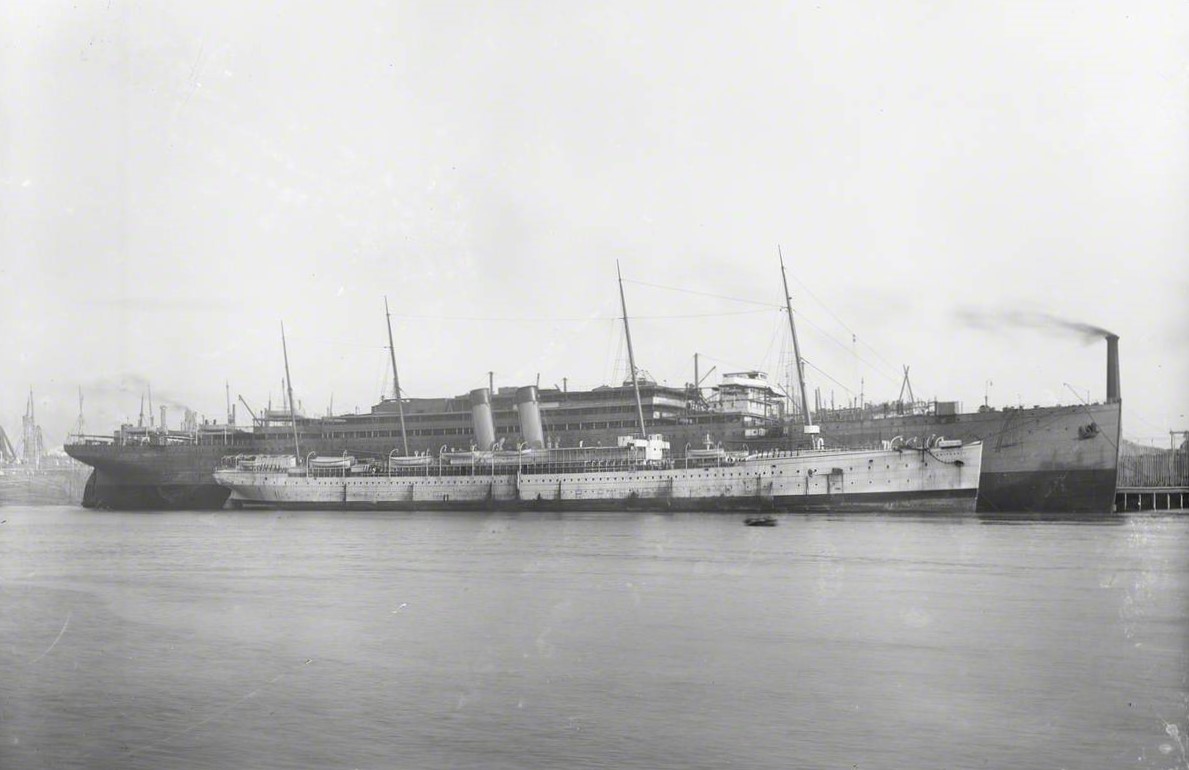
12. ábra: A CEDRIC a vízrebocsátás után a szerelőparthoz kötve a BRITANNIC (I) társaságában. A CEDRIC térfogata négyszeresen múlta felül elődjéét. (fotó: Robert Welsh, Ulster Folk and Transport Museum, National Museums of Northern Ireland)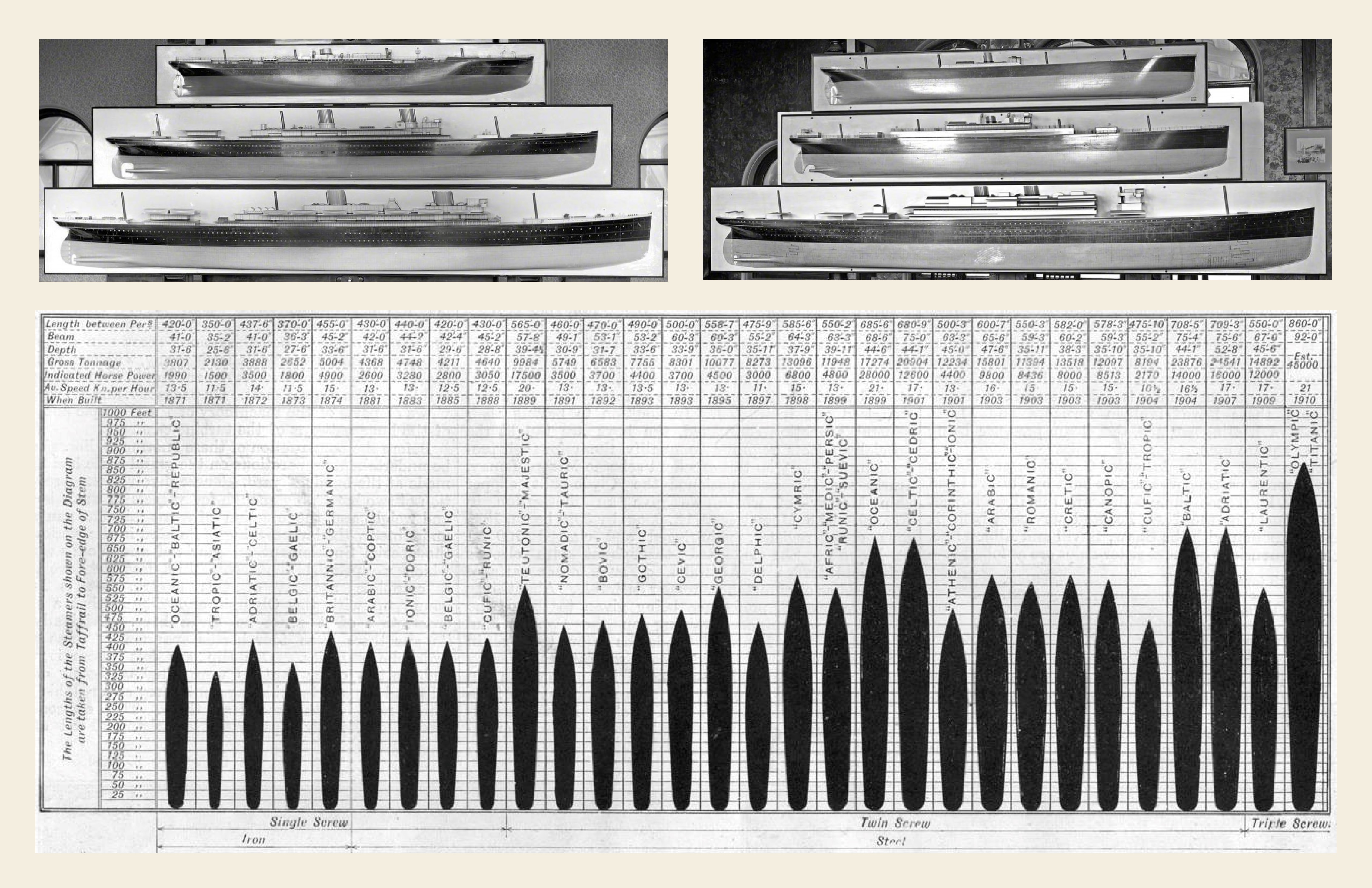
13. ábra: A White Star Line hajóinak fejlődése. Fent balra az OCEANIC (I), a TEUTONIC és az OCEANIC (II), fent jobbra pedig a CEVIC, RUNIC, CELTIC gyári félmodelljei. (fotó: Robert Welsh, Ulster Folk and Transport Museum, National Museums of Northern Ireland, első kép, második kép)
1902.08.23.: A Nagy Négyes negyedik egysége, a 358-as gyártmányszámú egység megrendelése.
1902.11.18.: A 358-as gyártmányszámú egység gerincfektetése.
1903.01.31.: A CEDRIC hivatalos átadása.
1903.04.15.: A CELTIC összeütközik a HEATHMORE gőzhajóval, Liverpool előtt, a Mersey-folyón. A hajótesten kisebb lék támad, amelyet javítani kell.
1903.11.21.: A 352-es gyártmányszámú egység vízrebocsátása BALTIC néven.
1903.11.26.: A CELTIC rakterében keletkezett tűz elpusztítja a hajón lévő gyapotrakományt.
1904.06.23.: A BALTIC hivatalos átadása.
1904.09.24.: A CELTIC a legénységgel együtt 2 957 fővel megérkezik New Yorkba. Eddig ez a White Star Line által egyetlen hajóúton szállított legmagasabb létszám. Ugyanebben a hónapban a CEDRIC 2 723 főt, a BALTIC pedig 2 890 főt szállít, vagyis a Nagy Négyes addig elkészült három tagja együtt, alig három hét leforgása alatt mindösszesen 8 570 utast szállít át az Atlanti-óceánon. A hajók építését megalapozó koncepció helyessége ezzel fényesen beigazolódik. Olyannyira, hogy a hajók sikere nyomán a rivális német hajótárasaságok, a H.A.P.AG és a Norddeutscher Lloyd is hasonló hajók (a KAISERIN AUGUSTE VICTORIA, az AMERICA és a GEORGE WASHINGTON) felépítéséről döntenek. A német hajók közül az AMERICA Belfastban épül, a Harland & Wolff-nál, látványos igazolásaként annak, hogy William James Pirrie a WSL J. P. Morgan általi felvásárlását követően immár semmisnek tekinti a Sir Edward Harland és Thomas Henry Ismay közötti megállapodást, miszerint a hajógyár nem épít hajót a WSL riválisainak.
1905.03.12.-12.30.: A CELTIC az év folyamán 12 átkelést teljesít az Atlanti-óceánon Joseph Barlow Ranson és Bertram Hayes kapitányok parancsnoksága alatt. Azévi utolsó Amerikába tartó útján, december 25-én egy óriáshullám hatalmas csapást mér a hajóra, megrongálva a másodosztályú létesítményeket (a hullám betörte a dohányzó ablakait, leszakított egy 4 tonnás beszállóajtót a hajótestről és elsodorta a fedélzeti korlát egy 30 méternyi szakaszát, alaposan ráijesztve az utasokra).
Az óriáshullám – a mély vizekben szinte észrevétlen szökőárral szemben – rövid ideig létező, a szignifikáns hullámmagasság több mint kétszeresét meghaladó magasságú epizodikus hullámjelenség, amely akkor alakul ki, amikor egy normális ún.: nem lineáris hullám bizonyos környezeti tényezők (pl.: szél, áramlások) kölcsönhatásának eredményeként (a lineáris szuperpozíció hatására) energiát nyer a környező hullámokból és rövid időre a korábbi mérete sokszorosára nő, különös veszélyt jelentve a hajózásra.
1906.01.31.-12.07.: A CELTIC az év folyamán 11 alkalommal kel át az Atlanti-óceánon Joseph Barlow Ranson kapitány parancsnoksága alatt.
1906.09.20.: A 358-as gyártmányszámú egység vízrebocsátása ADRIATIC néven.
1907.04.25.: Az ADRIATIC átadása.
14. ábra: A Nagy Négyes hajói csak első ránézésre tűnnek teljesen egyformának. Valójában az első két és az utolsó két egység páronként jobban hasonlít egymásra, mint a másik páros bármelyik tagjára. A BALTIC és az ADRIATIC például a maga 24 570 tonnás térfogatával 17 %-kal nagyobb, mint a 20 904 tonnás CELTIC és CEDRIC. Az ADRIATIC esetében a gépteljesítményt is növelik annak érdekében, hogy a hajó sebességét 17,5 csomó (32,4 Km/h) fölé fokozhassák: a 8 kétvégű kazán mellé így további 4 egyvégű kazánt is beépítenek. A fenti rajzon az első és a második páros eltérései láthatók (rajz: Dr. Balogh Tamás) az alábbiak szerint:
- Vörös körben az osztott felépítmény hátsó részén kialakított három felépítmény-sziget egymáshoz képesti helyzete és eltérő beépítése látható (a csónaktartó állványok alatti, oldalfalakkal határolt helyiségek léte vagy hiánya, illetve a felépítmény-szigetek különböző - 1-2 fedélzetnyi - magassága), valamint az árbocdaruktól elkülönített fedélzeti rakodódaruk pozíciója (ahol releváns - vagyis, amelyik hajón ilyen jelölés nincs, ott az elrendezés az előző hajón láthatóval azonos).
- Vörös szaggatott vonalak jelölik az osztott felépítmény középső részének és hátsó (hármas) felépítmény-csoportjának hossza, illetve a köztük lévő távolság hajónkénti változásait (ahol releváns - vagyis, amelyik hajón ilyen jelölés nincs, ott az elrendezés az előző hajón láthatóval azonos).
- 1-2-3-4 számok jelölik a felépítmények mellvédjének hajónként és fedélzetenként eltérő (tömör lemezmellvédes, illetve szalagkorlátos) kialakítását és hosszát (ahol releváns - vagyis, amelyik hajón ilyen jelölés nincs, ott az elrendezés az előző hajón láthatóval azonos).
1907.04.30.: A White Star Line megbízást ad a belfasti Harland & Wolff Hajógyárnak, hogy készüljön fel három nagy óceánjáró személyszállító gőzhajó (a későbbi OLYMPIC-osztály) felépítésére, s a megrendelői specifikáció alapján kezdje meg a részletes tervek kidolgozását.
1911.10.20.: Robert MacGuffie fedélzeti steward eltűnik (valószínűleg lesodorja egy hullám a fedélzetről). Az utasok 500 dollárt gyűjtenek az özvegye és gyermekei megsegítésére.
1912.04.14.: A New Yorkból három napja útra kelt BALTIC jeget jelent az avató útján New Yorkba tartó TITANIC-nak. Másnap hajnalban pedig az éjjel jéghegynek ütközött óceánjáró mentésére igyekszik – hiába.
1912.04.18.: Joseph Bruce Ismay a CEDRIC fedélzetén kívánja hazaküldeni a TITANIC túlélő legénységét, ám az időközben elrendelt szenátusi meghallgatások miatt a hajó nélkülük indul vissza Európába.
1912.05.02.: Joseph Bruce Ismay a szenátusi vizsgálat befejezését követően az ADRIATIC fedélzetén Liverpoolba érkezik (a TITANIC túlélő legényégét a LAPPLAND nevű Red Star Liner szállítja Angliába).
1912.12.31.: Joseph Bruce Ismay megerősíti, hogy januári elhatározásának megfelelően 1913.06.30. hatállyal lemond. Bejelentését 1913.01.02-án elfogadják. A White Star Line új elnök-vezérigazgatója a korábbi alelnök, Harold Sanderson.
1913.01.23.-12.05.: A CELTIC az év folyamán 11 átkelést teljesít az Atlanti-óceánon Frank Ernest Beadnell és Alexander Elvin Sherwin Hambelton kapitányok parancsoksága alatt.
A transzóceáni személyközlekedés konjunktúrája a TITANIC tragédiája ellenére is töretlen: míg 1912-ben a Nagy Négyes hajói összesen 68 000 embert szállítottak oda-vissza az óceán két partja közt, addig 1913-ban már nem kevesebb, mint 77 000 embert, 1914 végéig pedig a négy hajó együttes teljesítménye a szolgálatba állításuktól kezdve eltelt teljes időre vetítve összesen 850 000 főt jelentett.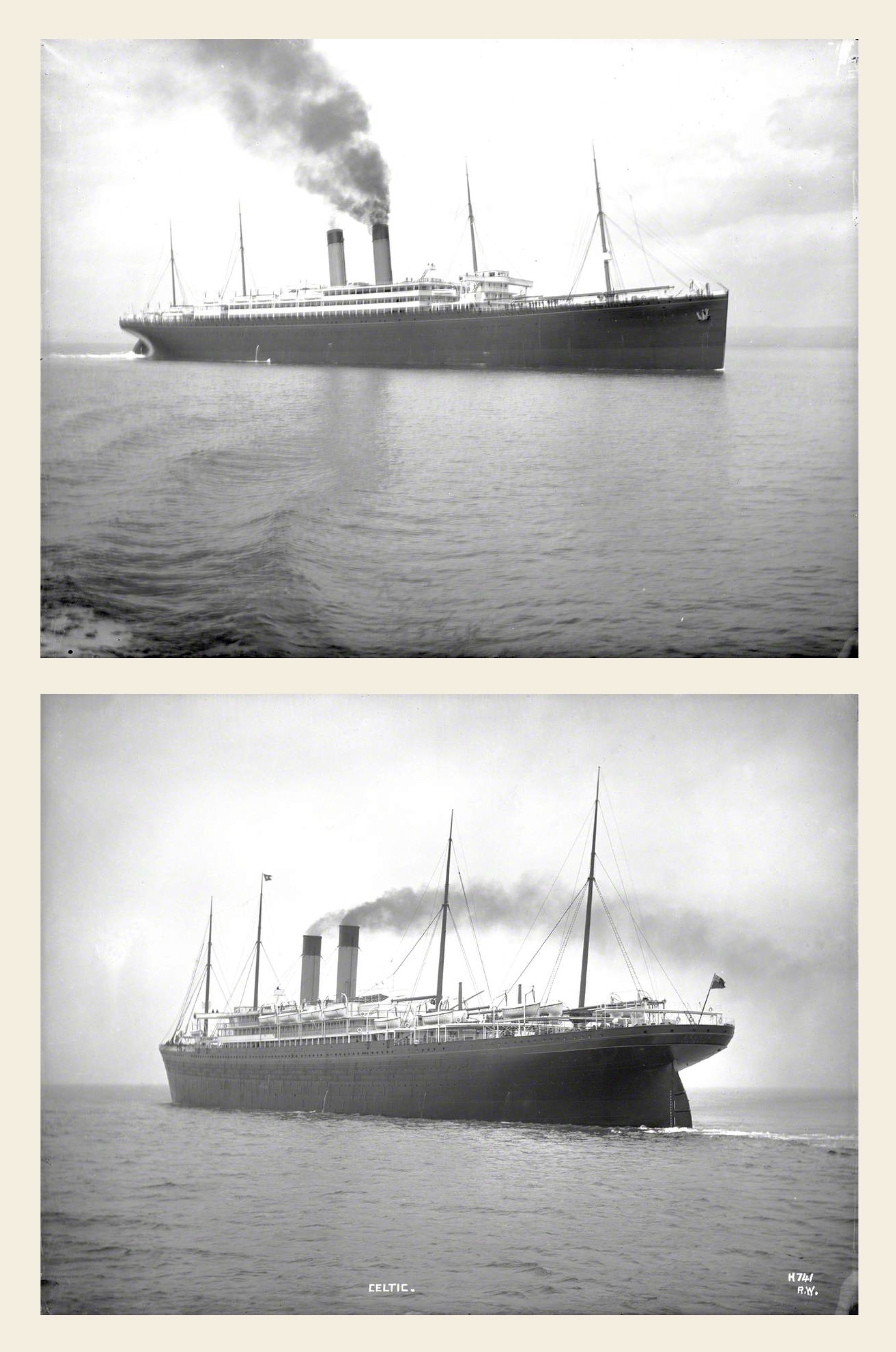
15. ábra: A CELTIC kisebb sebessége ellenére is az első világháborút megelőző időszak népszerű hajói közé tartozott. Ennek egyik oka abban keresendő, amit a Scientific American c. folyóirat így foglalt össze: "A transzatlanti kereskedelmi gőzhajókat két, egymástól mereven elkülönülő típusba sorolták egykor - az egyik típust főleg utasok és posta, a másikat kizárólag teheráru szállítására használták. A postagőzösökéhez képest kevésbé fényűző és olcsóbb szállások iránt a legutóbbi években felélénkült kereslet arra késztette a hajótársaságokat, hogy tehergőzöseik közül a gyorsabbakon bizonyos számú szálláshelyet is biztosítsanak; ez az új kezdeményezés olyan sikeresnek bizonyult, hogy egy teljesen új típusú gőzhajót eredményezett, olyanokat, mint most a CELTIC, amely típusának legnagyobb és legnépszerűbb képviselője." (fotó: Robert Welsh, Ulster Folk and Transport Museum, National Museums of Northern Ireland, első kép, második kép)
1914.01.08.-05.25.: A CELTIC az első félév folyamán 3 átkelést teljesít New York és Alexandria (Egyiptom) között Nápoly és Madeira érintésével Alexander Elvin Sherwin Hambelton kapitány parancsoksága alatt.
1914.06.11.-10.08.: A CELTIC az év hátralévő részében – az első világháborúba történt 1914.08.04-i brit belépést követő időszakot is beleértve – 5 átkelést teljesít az Atlanti-óceánon Liverpool és New York között oda-vissza Alexander Elvin Sherwin Hambelton kapitány parancsoksága alatt.
1914.11.01.-1915.08.02.: A CELTIC „behívót” kap: a hajót a hajótársaság és a brit kormány között kötött szerződés értelmében felfegyverzik (a hajót 8 db 6 hüvelykes gyorstüzelő ágyúval szerelik fel) és a flotta segédhajójaként veszik igénybe a háborúban Oswald McDonough English sorhajókapitány parancsoksága alatt azzal a feladattal, hogy a Csendes-óceáni brit hajóraj ellátóhajójaként tevékenykedjen.
1915.08.02.-1916.01.04.: A CELTIC hadiszolgálatban Christopher Russell Payne sorhajókapitány parancsoksága alatt. A hajó 1915.08.23.-09.07. között a délafrikai Simonstown-ban szárazdokkba áll, ahol elvégzik a víz alatti részei karbantartását, azt követően pedig egészen 1915.12.01.-ig az öbölben marad, hogy a gépészeti felújítását is végrehajthassák.
1916.04.19.-12.03.: A CELTIC-et elbocsájtják a fegyveres hadiszolgálatból, s az év további részében csapatszállítóként 7 átkelést teljesít az Altanti-óceánon Liverpool és New York között oda-vissza Alexander Elvin Sherwin Hambelton kapitány parancsoksága alatt, akit az év végén a JUSTICIA (ex-STATENDAM) óceánjáró parancsokává neveznek ki.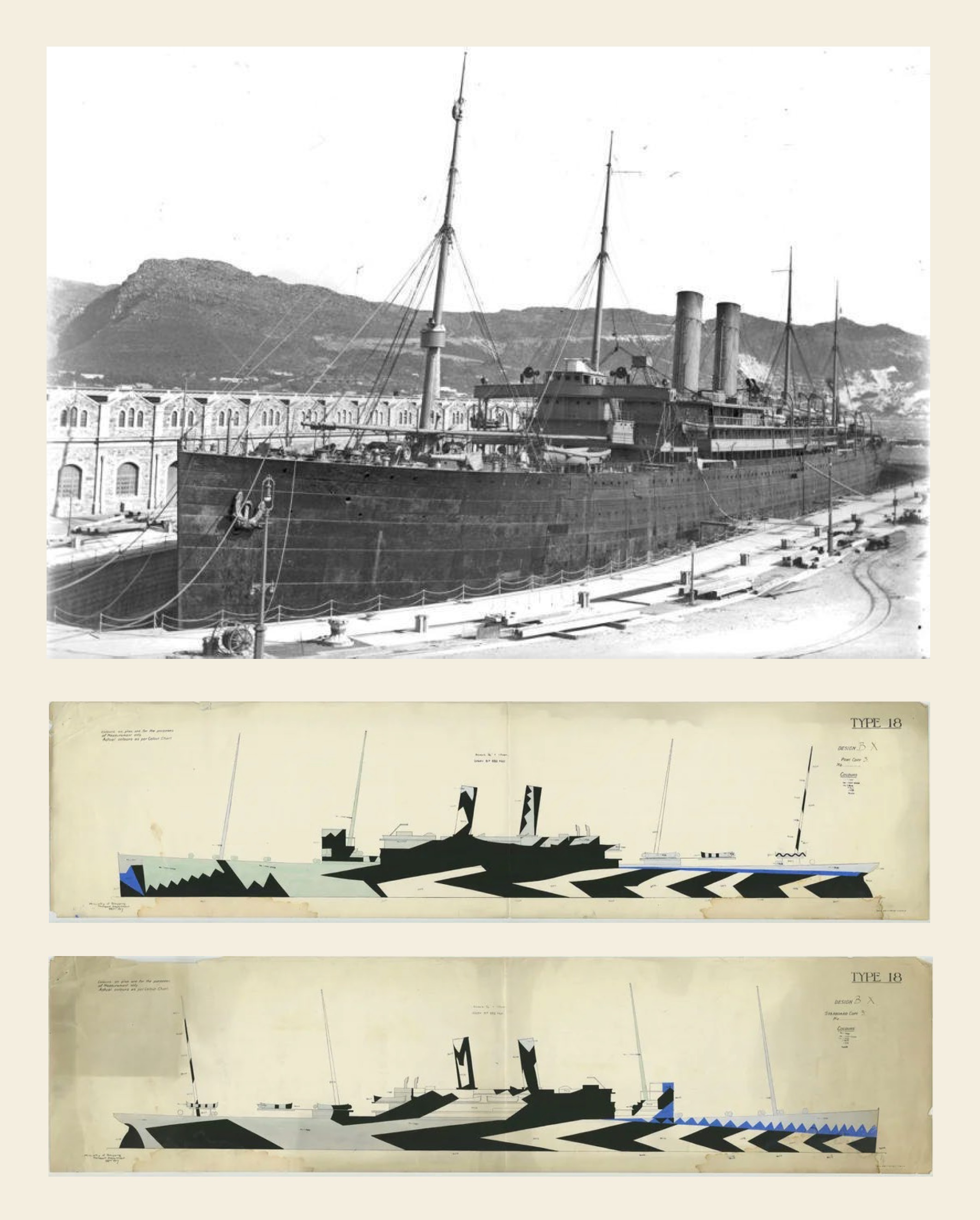
16. ábra: A CELTIC felfegyverzett segédcirkálóként a simonstown-i szárazdokkban (fent). A képen jól láthatók az orrfedélzet peremén és az osztott felépítmény felépítménycsoportjai közötti fedélzetrészeken felállított gyorstüzelő ágyúk (forrás). Középen és lent a hajón a fegyveres hadiszolgálatból történt elbocsátását követően a tengeralattjáró-parancsnokok megzavarása érdekében alkalmazott álcázófestés látható (forrás).
1917.01.03.-04.21.: A CELTIC két utat tesz meg Liverpool és New York között John Bradshaw kapitány parancsnoksága alatt.
1917.02.14.: A CELTIC aknára fut a Man-sziget előtt. A fedélzeten tartózkodók közül 17 ember meghal, de a hajó úszóképes marad, s a CANADA gőzös vontájában ér Peel Bay-be, ahonnan később Belfastba vontatják, ahol teljesen kijavítják, majd a haditengerészet hadihajóinak történő fűtőolaj-szállításra alakítják át.
1917.05.13.: Az U-57 jelű német tengeralattjáró sikertelen torpedótámadása a hajó ellen (a torpedó célt téveszt).
1917.06.11.-12.26.: A javítást követően a CELTIC 5 átkelést teljesít az Alanti-óceánon Liverpool és New York között oda vissza Hugh Frederick David kapitány parancsnoksága alatt.
1918.02.27.-12.17.: A CELTIC 3 átkelést teljesít az Alanti-óceánon Liverpool és New York között oda vissza Hugh Frederick David és Alexander Elvin Sherwin Hambelton kapitányok parancsnoksága alatt.
1918.03.31.: Az U 77-es tengeralattjáró megtorpedózza a hajót az Ír-tengeren. Hatan meghalnak, de a CELTIC ezúttal is úszóképes marad (a tengerészek szerint azért, mert a tengeralattjáró mindkét oldalról megtorpedózta, így egyenletes elárasztás mellett nem dőlt meg és nem mozdult el a rakomány sem). Sikerül Liverpoolba vontatni, ahol ismét kijavítják.
1919.05.17.: A CELTIC-et a brit kormány visszaadja a White Star Line-nak, amely Belfastba küldi felújításra.
1919.08.14.: A CELTIC testvérhajója, az ADRIATIC részt vesz az első légi-tengeri postaszálítási kísérlet megvalósításában melynek keretében légipostai küldeményt kézbesítenek az Egyesült Államokból a nyílt óceánra tartó hajóra.
1920.01.01.-12.29.: A CELTIC 9 átkelést teljesít az Alanti-óceánon Liverpool és New York között oda vissza Richard Owen Jones kapitány parancsnoksága alatt.
1921.01.08.-12.26.: A CELTIC 12 átkelést teljesít az Alanti-óceánon Liverpool és New York között oda vissza Frank Briscoe Howarth, Frank Ernest Beadnell és John Roberts kapitányok parancsnoksága alatt.
1921.04.24.: Az EVERETT nevű szénszállító kis híján a CELTIC-nek ütközik a sűrű ködben a NANTUCKET világítóhajó közelében. Az ütközést az utolsó pillanatban sikerül elkerülni, de a CELTIC oldala így is behorpad, ahol a szénszállító végigsúrolja.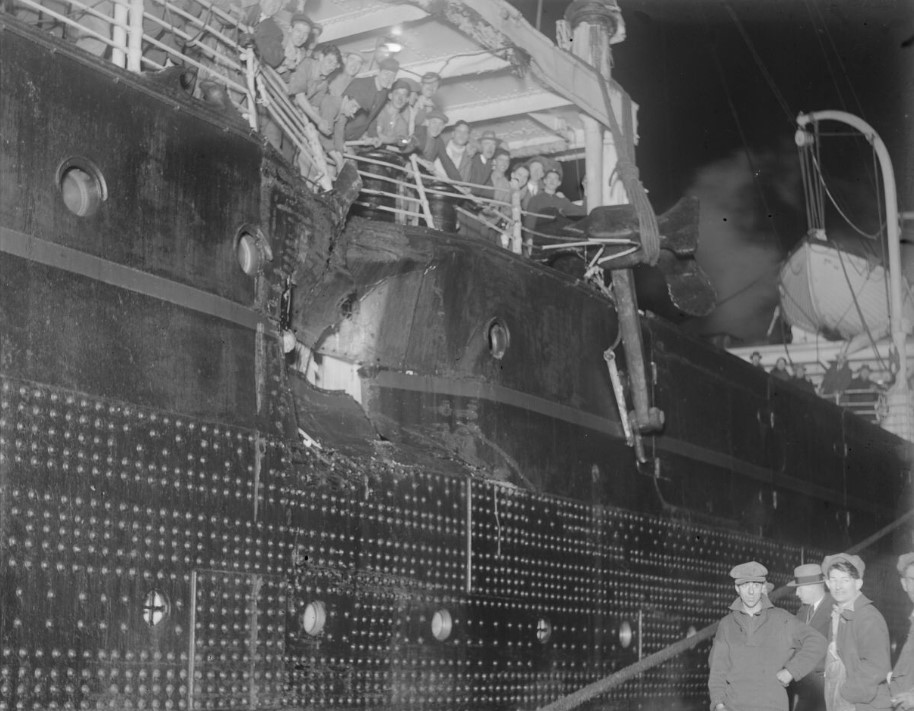
17. ábra: A CELTIC sérült oldala az ütközés után. (fotó: Leslie Jones, Boston Public Library, Leslie Jones Collection)
1922.02.18.-12.11.: A CELTIC 11 átkelést teljesít az Alanti-óceánon Liverpool és New York között oda vissza John Roberts és William Marshall kapitányok parancsnoksága alatt.
1925.04.25.: A CELTIC véletlenül nekiütközik a Coast Line HAMPSHIRE COAST nevű hajójának a Mersey-folyón. Mindkét hajó csak kisebb károkat szenved. Ugyanebben az évben a CELTIC elveszíti a hajócsavart a bostoni kikötőben, és vissza kell térnie a dokkba, így utasai vonattal indultak New Yorkba, hogy ott egy másik hajóra szálljanak át.
1926.11.01.: Lord Kylsant, a brit Royal Mail Steam Packet Co. hajótársaság tulajdonosa és vezérigazgatója felvásárolja a White Star Line többségi részvénypakettjét amerikai tulajdonosaitól, akik bejelentik, hogy felbontják a Harland & Wolff Hajógyárral kötött szerződést. A White Star Line amerikaiból újra brit tulajdonba kerül, s csatlakozik a Royal Mail Steam Packet Co. vezette konglomerátumhoz.
1927.01.29.: Az amerikai Diamond Lines ANACONDA nevű hajója a sűrű ködben a CELTIC-nek ütközik a Fire Island közelében. A balesetet követő felújítást a White Star Line felhasználja a hajó átalakítására, annak érdekében, hogy a CELTIC lépést tarthasson az Atlanti-óceán északi részén szolgálatba állított legújabb hajókkal. Az addigi háromosztályos rendszert ekkor feladják, s a hajót 2 500 kabinosztályú utas számára rendezik be.
1927.04.14.: A kiöregedett Nagy Négyes pótlására megrendelt BRITANNIC (III) – korszerű közepes méretű kabinos motorhajó – gerincfektetése.
1928.12.01.: A CELTIC útnak indul New Yorkból Boston felé, ahol fedélzetére veszi a november 12-én elsüllyedt VESTRIS gőzös európai túlélőit, majd megkezdi atlanti átkelését az írországi Cobh és az angliai Liverpool felé Gilbert Parry kapitány parancsnoksága alatt. A hajó Cobh-i érkezését december 10-én hajnali 03:00 és 04:00 óra közt várják.
1928.12.10.: A CELTIC zátonyra fut.
Cobh-hoz közeledve az időjárás egyre romlik, ami azzal fenyeget, hogy lehetetlenné válik a révkalauz felvétele, akinek a jelenléte szükséges a kikötő előtti horgonyzóhely biztonságos megközelítéséhez. Gilbert Berry kapitány ezért úgy dönt, hogy ha nem javul az idő, akkor az írországi megálló mellőzésével közvetlenül Liverpoolba megy. A CELTIC fogadására felkészült révkalauz-szolgálat hajnali 03:00 órakor észleli a CELTIC fényeit néhány mérföldnyire a Cobh-i kikötő bejáratától délkeletre. Bár az erős délnyugati szél időközben orkánná fokozódik, Berry kapitány úgy véli, hogy a 04:11-re előre jelzett dagály idején képes lesz felvenni a révkalauzt, ezért lassan közelít a CELTIC-kel a kikötő bejáratához, s már majdnem biztonságos vizekre ér, amikor 04:55-kor egy heves széllökés a Roches-fok előtti Cow and Calf sziklákra taszítja egy hatalmas reccsenés kíséretében. Az erőteljes becsapódás hatására az étkezőben lévő asztalnemű az asztalokról a fedélzetre esik és összetörik, több utas az egyensúlyát vesztve elesik, a CELTIC testén pedig remegés fut végig, ahogy a még mindig forgó hajócsavarok igyekeznek előre hajtani a zátonyon rekedt hajót, amely az oldalát paskoló hullámverésben ide-oda billeg.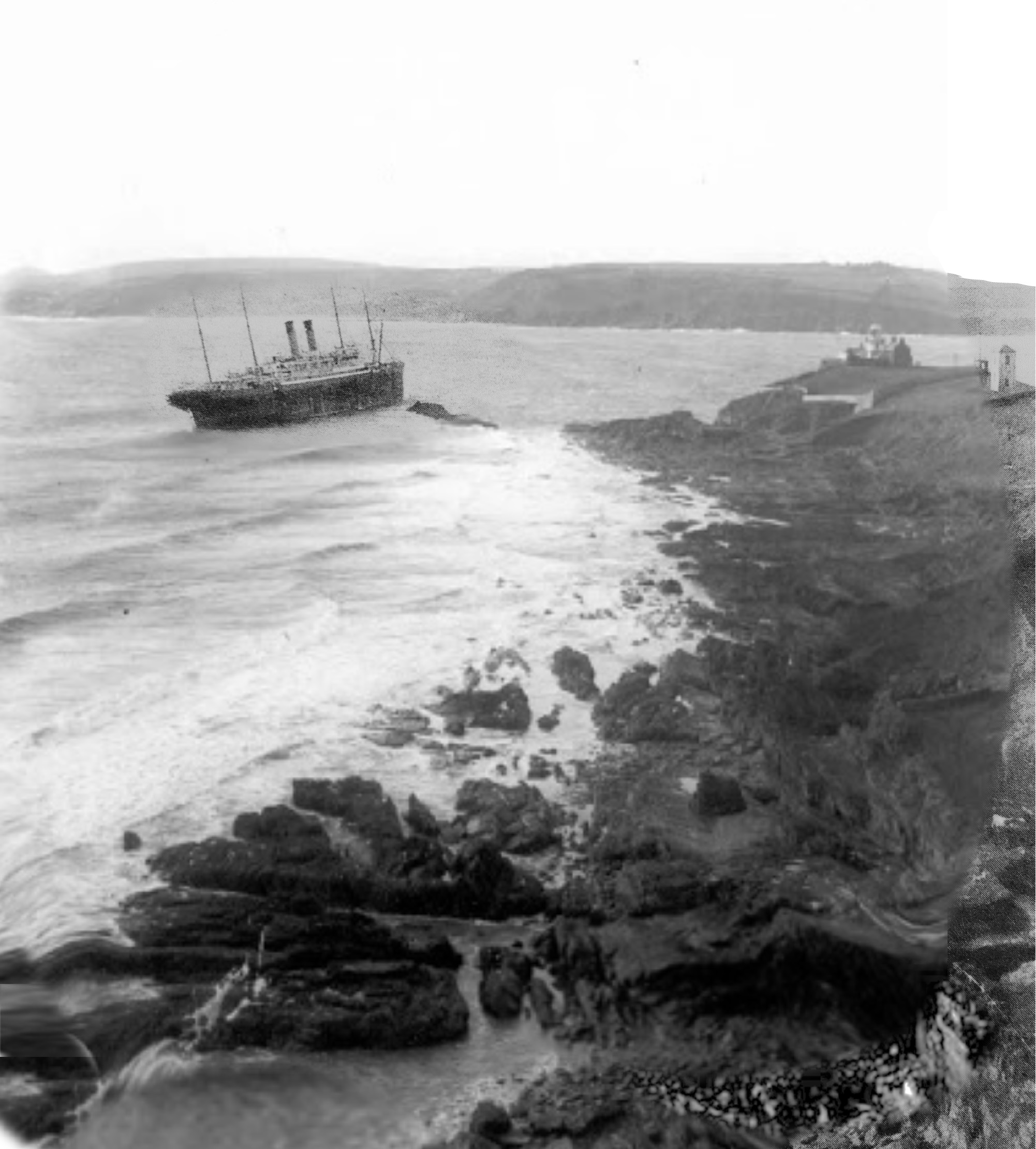
18. ábra: A CELTIC a zátonyon. (forrás)
Parry kapitány hat rövid hangjelzést ad a CELTIC gőzsípjával, jelezve a közelben lévő hajóknak, hogy mentést kér, az utaskísérők pedig végig járják a kabinokat és felszólítják az utasokat a mentőmellények felvételére és a csónakfedélzeten való gyülekezésre. Köztük van Albert Knill steward, a VESTRIS 13-as számú mentőcsónakjában megmenekült 13 túlélő egyike is, akit a hajó elsüllyedése utáni napon, 13-án mentettek ki a tengerből, tengeri szolgálatának 13. esztendejében. Bár ez rövid időn belül már a második hajótörése, a VESTRIS fedélzetén átéltekhez képest igazi pikniknek érzi, hiszen alig tíz perccel az ütközés után a CELTIC utaskísérői már forró kávét szolgálnak fel a csónakfedélzeten gyülekezőknek. A mentőcsónakokat leeresztésre készen kifordították, s felkészültek a csónakba szállásra, ám a viharos időben túlságosan veszélyesnek tartott műveletet hamarosan lefújták, amikor kiderült, hogy a hajót nem fenyegeti az elsüllyedés közvetlen veszélye, így az utasokat visszaterelték a hajó belsejébe, s a szokott időben, 06:30-kor felszolgálták számukra a reggelit az étkezőben, ahol ugyanúgy megterítették az asztalokat, mint mindig, mintha mi sem történt volna.
A mentőhajók – a GELEZEE nevű holland vontató és a MORSECOCK nevű helyi vontató – közben eredménytelenül igyekeznek a CELTIC közelébe jutni. Csak jóval a reggeli után sikerül átvenniük a vontatóköteleket, s akkor megkísérlik az óceánjáró levontatását a zátonyról, ám több órányi próbálkozás után végül feladják, mivel a dagály elvonultával a feladat még kivitelezhetetlenebbé válik. Annak érdekében, hogy megkönnyebbüljön a hajó, a vontatók segítségével kihajózzák az utasokat és a poggyászt, az utasokat vonat viszi Belfastba, ahonnan másnap reggel 06:00 órára érnek Liverpoolba. A hajón csak a tisztek, a gépészek és a fedélzeti matrózok maradnak, jól tudva, hogy a hullámverésben a zátonyon töltött minden perc fokozza a veszélyt, amibe a CELTIC került. 15:30-kor a brit Királyi Haditengerészet HMS SEAME rombolója igyekszik levontatni az óceánjárót a zátonyról, amely járó motorokkal igyekszik segíteni a művelet sikerét. 17:00-órakor azonban felhagynak a kísérlettel, mivel a CELTIC belsejében emelkedni kezd a víz. 17:30-kor már 12 láb (3,7 m) mélyen áll a No 3. raktérben, 11 láb (3,4 m) mélyen a 3-as és 5-ös fűtőállásban, valamint 3 láb (0,9 m) mélyen a gépházban, a tartálytető felett, s a kettős fenékbe épített tartályok egyike teljesen megtelt. Ilyen körülmények között a gépek további működtetése kizárt, a mélyebb vízbe vontatás pedig a hajó elsüllyedésével fenyeget.
1928.12.11.: A vízszint 25 lábnyira (7,2 m-re) emelkedik a No 3. raktérben, de a vízbetöréssel érintett többi rekeszben is romlik a helyzet. Kéziszivattyúkkal igyekeznek csökkenteni a betört mintegy 6 000 tonna víz mennyiségét, egyben ellenőrzés alatt tartani a helyzetet. A helyszínre érkezik Charles Alfred Bartlett, a White Star Line hajózási főfelügyelője (a TITANIC fiatalabb testvére, a BRITANNIC (II) kapitánya annak 1916-ban történt elsüllyedése idején), aki a CELTIC bejárása után azt valószínűsíti, hogy a szikla kevéssel a parancsnoki híd előtt támasztja alá az óceánjárót, amelynek a középső részén emiatt nagy feszültség halmozódik fel, amint az erős hullámzás újra meg újra a hajótestet püföli. A Harland & Wolff Hajógyár, a Cobh-i tengerészeti főfelügyelő és a biztosító társaságok képviselőivel egyeztetés kezdődik a hajó étkezőszalonjában, amelynek az eredménye az, hogy ha sikerülne a zátonyról levontatni és úszóképes állapotban tartani a hajót, még akkor is kérdéses, hogy hol lehetne kijavítani. Végül úgy döntenek, hogy partra futtatják a néhány mérföldnyire lévő Whitebay-ben, ahol elvégezhetik a legszükségesebb javításokat, amelyekkel a hajó eljuthat Belfastba, ahol teljesen helyrehozhatják. A már a helyszínen lévő mentőhajókhoz a német SEEFALKE és a brit RESTORER vontatók csatlakoznak. Immár négy vontató igyekszik megszabadítani a CELTIC-et – eredménytelenül.
1928.12.14.: Az orrban lévő elülső és a tatnál lévő hátsó trimm-tartály, valamint a No 1. raktér kivételével az egész hajóban elöl és hátul is víz alatt van, vagy szivárgás. A rakományt – gyülömcsöt és vegyesárut – csak a No 1. és 2. raktér jobb oldaláról sikerül kirakodni.
1928.12.18.: A gépházban végzett intenzív szivattyúzás feltárja a hajófenék kiterjedt sérülését. Mivel a léket nem lehet megközelíteni, így lezárni sem lehet, ezért a hajó megmentése kivitelezhetetlen.
1928.12.28.: Megkezdik a hajóban maradt többezer tonna rakomány kiemelését.
1929.02.03.: A CELTIC levontatására tett utolsó kísérlet. A dagály tetőzésére időzített műveletet az orkánná fokozódó vihar miatt félbe kell szakítani.
1929.07.09.: A WSL eladja a roncsnak minősített hajót bontásra a dán Peterson & Albeck hajóbontó vállalkozásnak, amely 50 %-os részesedést ajánl fel a Hills of Dover Hajóbontónak, amely meg is kezdi a roncs helyszíni szétbontását.
Elsőként a kéményeket távolítják el, mivel azok akadályozzák a Roches-foki világítótorony fényjelzéseinek tiszta észlelését a tenger felől, majd a 4 árboc közül hármat emelnek ki, végül a felső fedélzet szintjéig lebontják az összes felépítményt. A maradék hajótestet az eredeti tervek szerint Rotterdamba vinnék, de amikor kiderül, hogy továbbra sem lehetséges levontatni a sziklákról, a helyben történő szétvágása mellett döntenek. A bontott anyag kiemelését és elszállítását eredetileg egy, a hajó nyílt tenger felőli oldalán kikötött úszódaruról tervezték végrehajtani, de az időjárás miatt a daru rögzítése lehetetlen, a part felőli oldalon pedig a mederviszonyok miatt csak egy jóval kisebb teherbírású darut sikerül elhelyezni a hajó mellé kötött pontonon, így végül a CELTIC fedélzeten építenek fel egy másik darut, hogy a két daru összehangolt munkájával hajtsák végre a bontást. A folyamatot a rakterekben maradt romlandó áru – szalonna, gabona – rothadása során és a széntárolókban maradt elázott szénből felszabaduló mérgező gázok hátráltatják, amelyektől vegyvédelmi intézkedésekkel és gázmaszkok használatával igyekeznek megvédeni a bontókat, akiknek végül 1933-ra sikerült befejezni a hajótest teljesen szétbontását.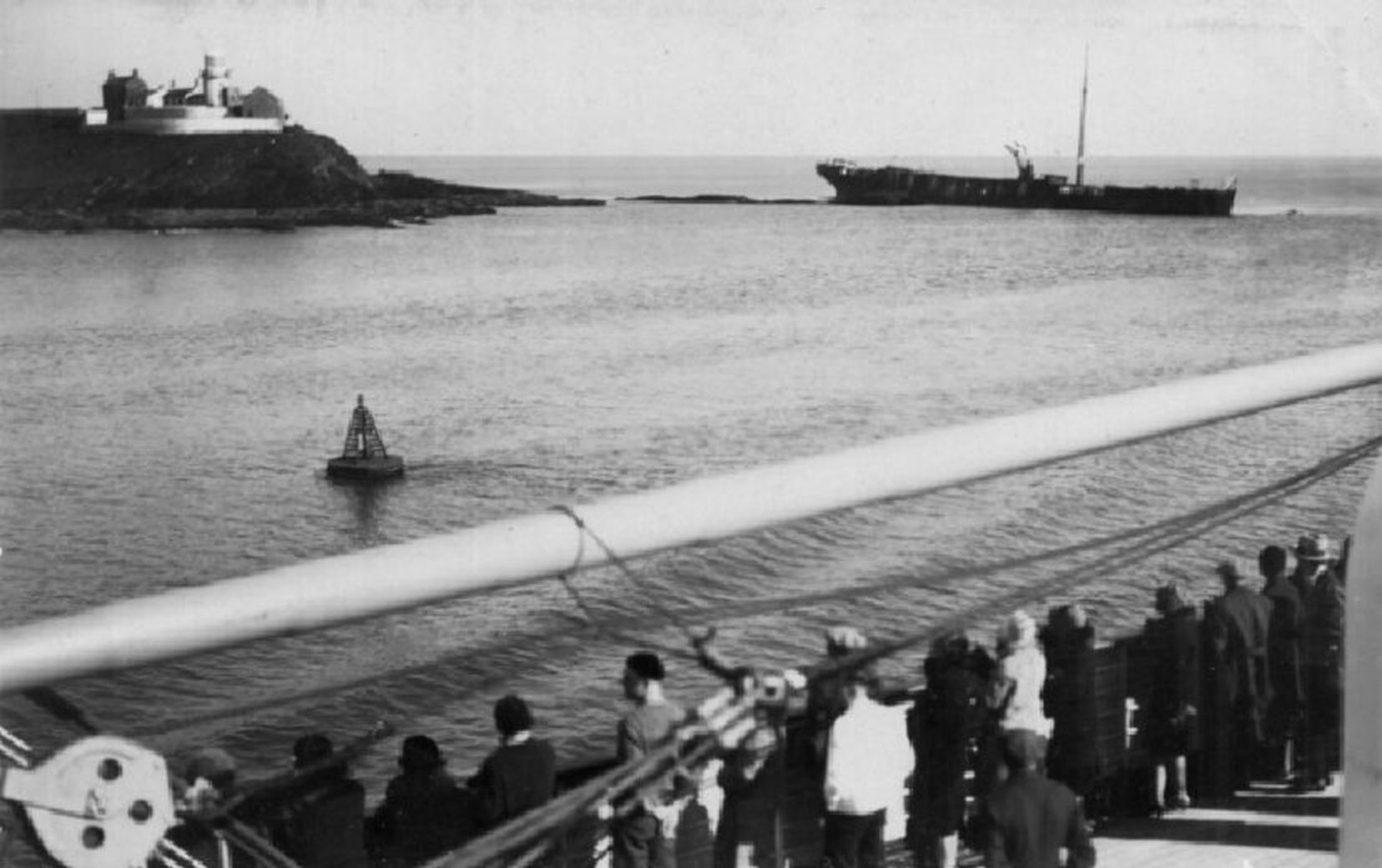
19. ábra: A CELTIC bontása 1932-ben. (forrás)
Források:
Chirnside, Mark: The ‘Big Four’ of the White Star Fleet: Celtic, Cedric, Baltic & Adriatic, The History Press 2017. ISBN-10 0750965975
de Kerbrech, Richard: Ships of the White Star Line. Shepperton: Ian Allan Publishing. ISBN 978-0-7110-3366-5
Eaton, John; Haas, Charles: Falling Star, Misadventures of White Star Line Ships. Patrick Stephens Ltd. 1989. ISBN 1-85260-084-5
Norway Heritage: The emigrant ship database, CELTIC (II)
Othfors, Daniel: CELTIC (II), in.: The Great Ocean Liners
The famous Big Four: brochure of the White Star Line, 1909.
Nagyszerű, ha tetszik a cikk és a benne megosztott képek. Ha érdeklik a szerző munkái, az Encyclopedia of Ocean Liners Fb-oldalán találhat további információkat a szerzőről és munkásságáról.
A képek megosztása esetén, a bejegyzésben mindig tüntesse fel az alkotó nevét. Köszönöm!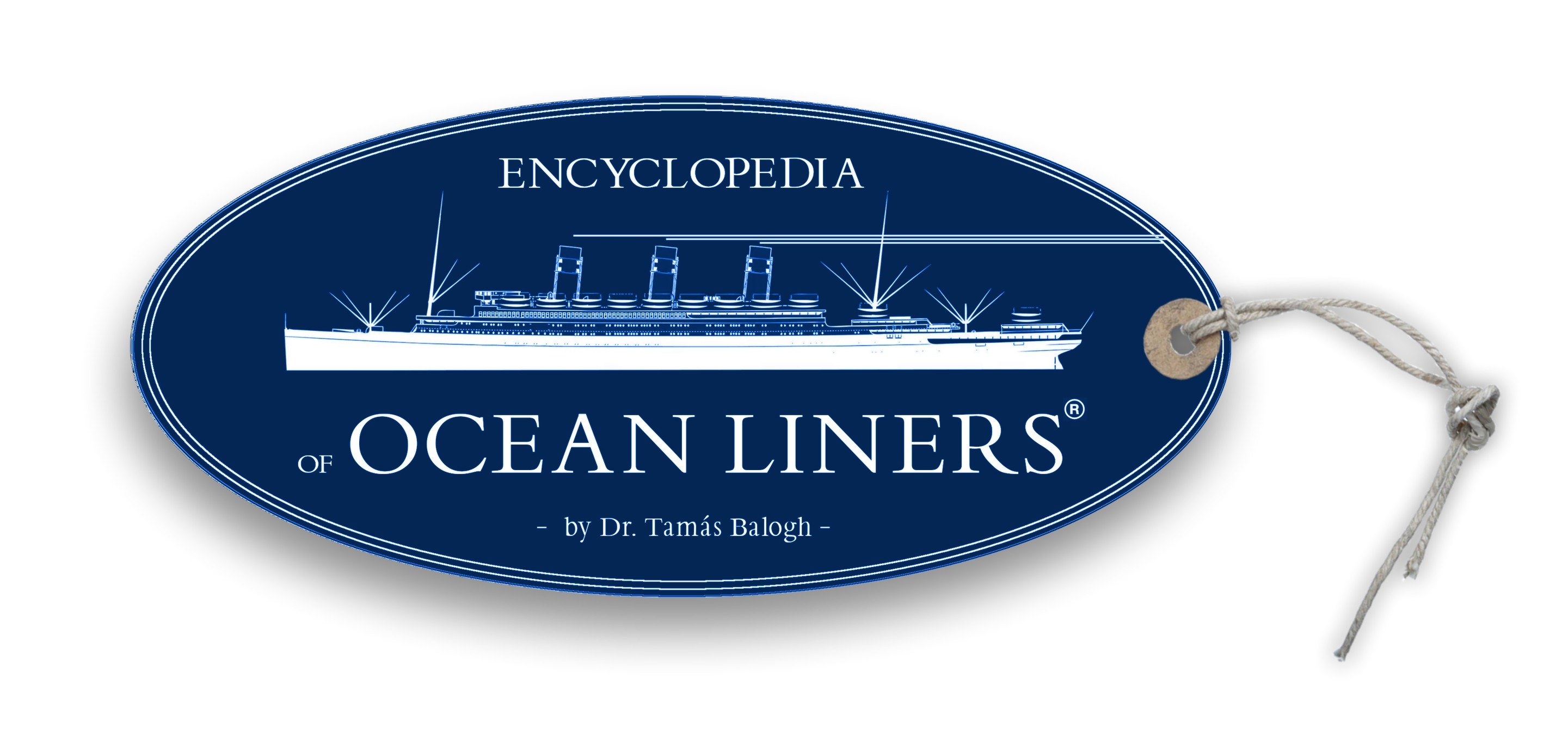
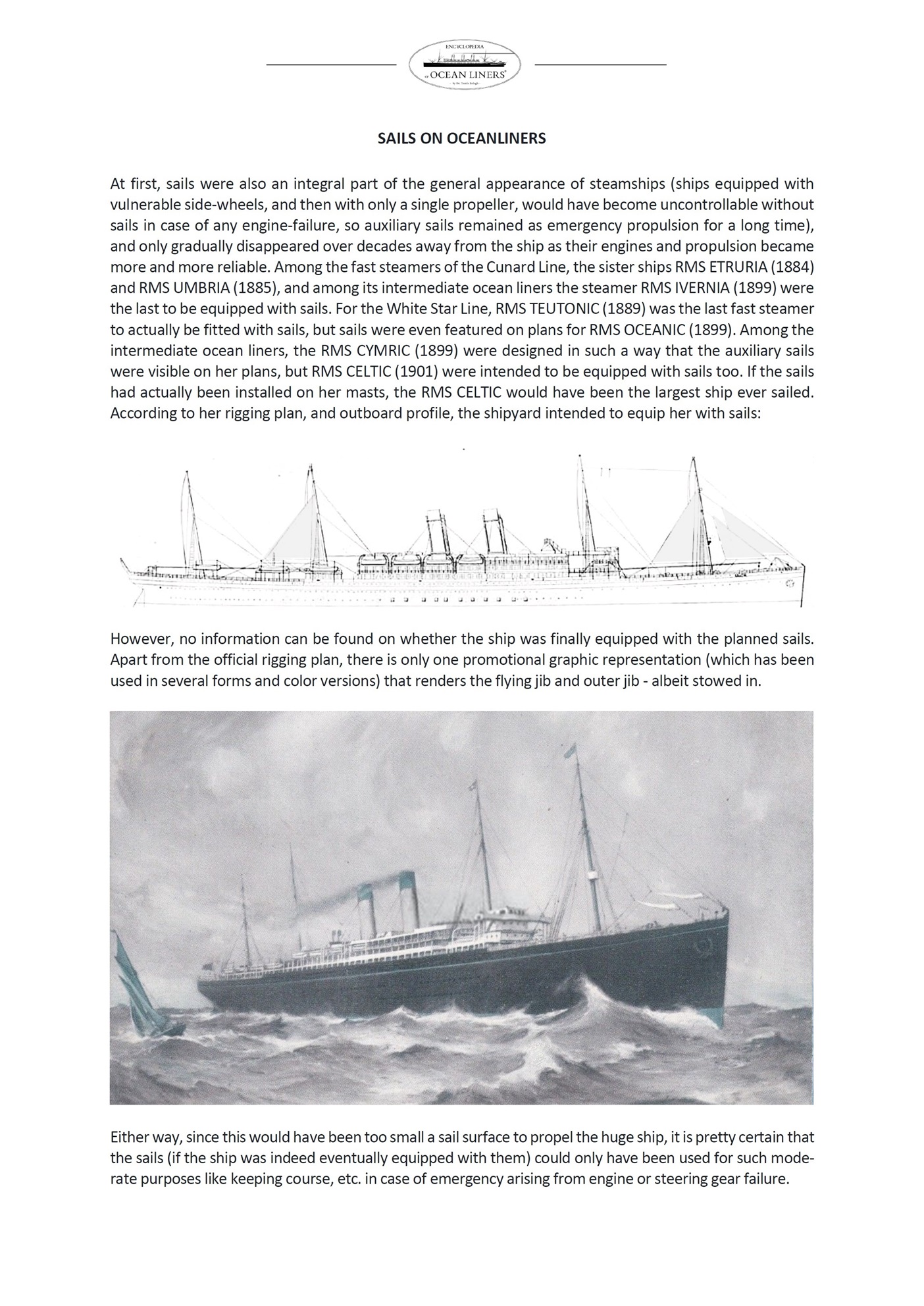
Utolsó kommentek